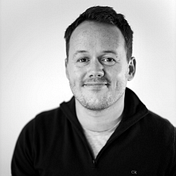The Eccentricities of J. Robert Oppenheimer
The so-called “Father of the Atomic Bomb” J. Robert Oppenheimer was once described as “a genius of the nuclear age and also the walking, talking conscience of science and civilization”.
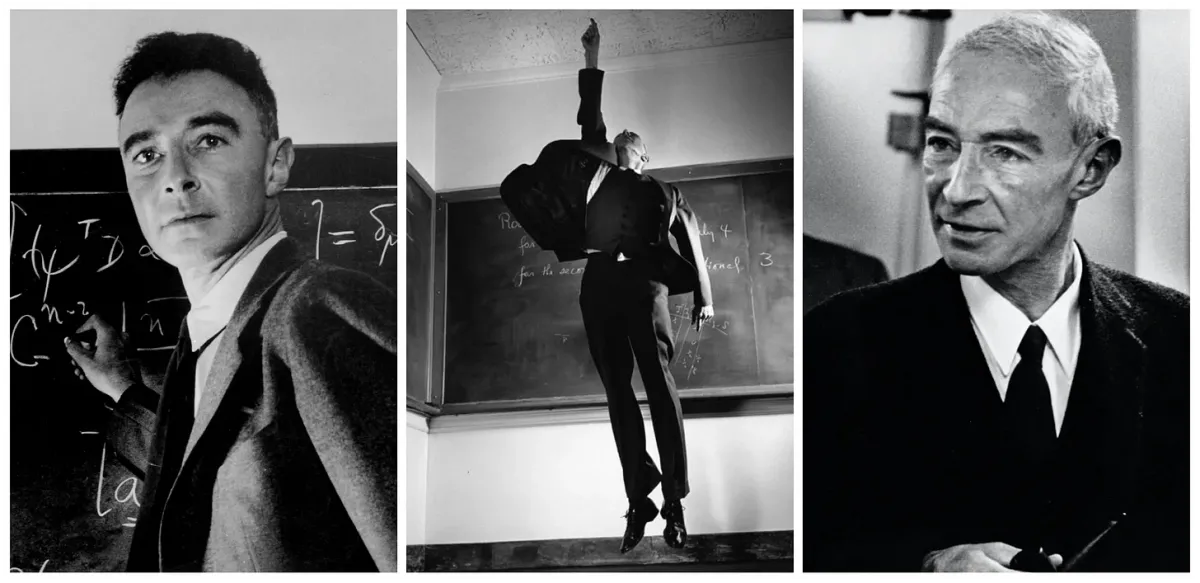
The eccentric and ingenious father of the atomic bomb
The so-called “Father of the Atomic Bomb” J. Robert Oppenheimer was once described as “a genius of the nuclear age and also the walking, talking conscience of science and civilization”. Born at the outset of the 20th century, his early interests in chemistry and physics would in the 1920s bring him to Göttingen University, where he worked alongside his doctoral supervisor Max Born (1882-1970), close lifelong friend Paul Dirac (1902-84) and eventual adversary Werner Heisenberg (1901-76). This despite the fact that even as early as in his youth, Oppenheimer was singled out as both gifted and odd, at times even unstable. As a child he collected rocks, wrote poetry and studied French literature. Never weighing more than 130 pounds, throughout his life he was a “tall and thin chainsmoker” who once stated that he “needed physics more than friends” who at Cambridge University was nearly charged with attempted murder after leaving a poisoned apple on the desk of one of his tutors. Notoriously abrupt and impatient, at Göttingen his classmates once gave their professor Born an ultimatum: “either the ‘child prodigy’ is reigned in, or his fellow students will boycott the class”. Following the successful defense of his doctoral dissertation, the professor administering the examination, Nobel Laureate James Franck (1882-1964) reportedly left the room stating
“I’m glad that’s over. He was at the point of questioning me”
From his time as student at Harvard, to becoming a postgraduate researcher in Cambridge and Göttingen, a professor at UC Berkeley, the scientific head of the Manhattan project and after the war, the Director of the Institute for Advanced Study, wherever Oppenheimer went he could hold his own with the greatest minds of his age. Max Born, Paul Dirac, John von Neumann, Niels Bohr, Albert Einstein, Kurt Gödel, Richard Feynman, they all admired “Oppie”. When he died in 1967, his published articles in physics totaled 73, ranging from topics in quantum field theory, particle physics, the theory of cosmic radiations to nuclear physics and cosmology. His funeral was attended by over 600 people, and included numerous associates from academia and research as well as government officials, heads of military, even the director of the New York City Ballet.
This week’s newsletter is an introduction to the life of Julius Robert Oppenheimer.
Early Life (1904–22)
Julius Robert Oppenheimer was born on April the 22nd, 1904 in New York City to parents Julius Oppenheimer and Ella Friedman. His father was an extroverted, wealthy textile importer who immigrated to the United States in 1888 at the age of 17 with no money, higher education or knowledge of the English language. His mother Ella was an accomplished painter who also collected art, including works by Picasso and Van Gogh. She also taught for a period, at Hunter College.
Robert’s parents had married a year before he was born. His father had prior to Robert’s birth already decided on naming his son Robert, but at the last moment, as the story goes, added a “J” in front of the name. According to Robert, the “J” didn’t stand for anything at all. On his actual birth certificate however, the name reads “Julius Robert Oppenheimer” after his father (Bird & Sherwin, 2005).
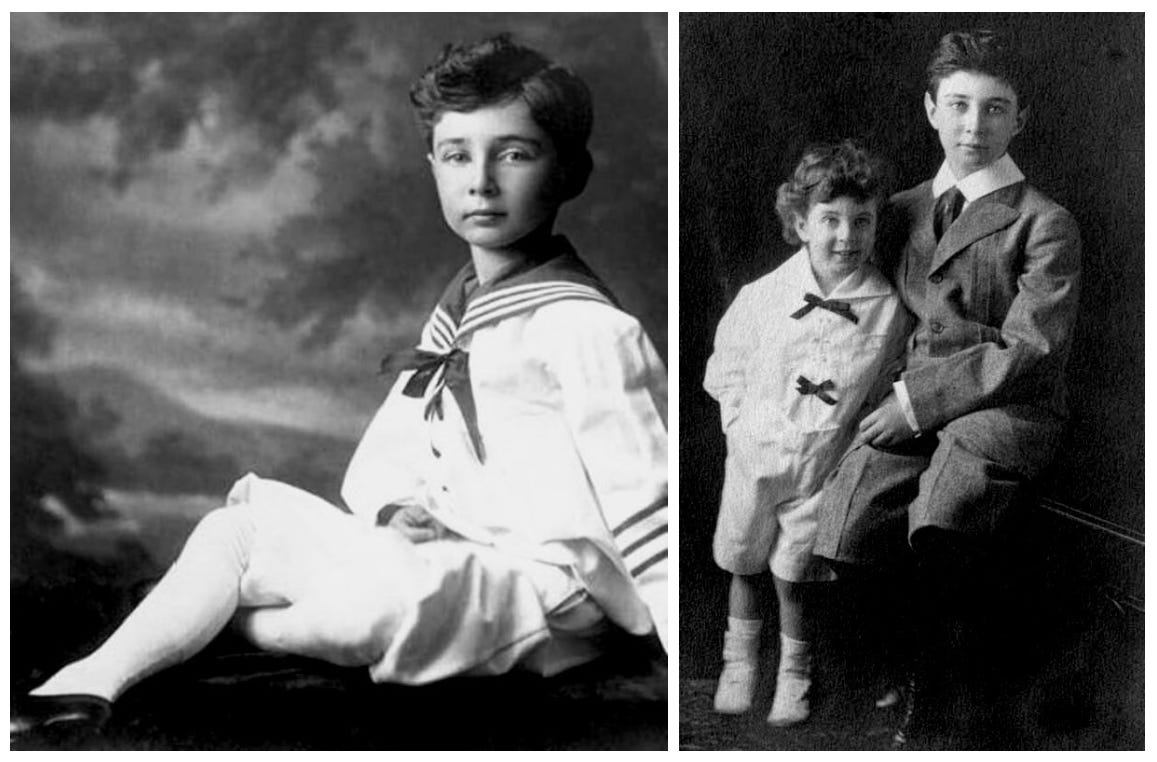
Oppenheimer had one sibling, his younger brother Frank, born in 1912. That same year, the family moved to an affluent neighborhood on the Upper West Side of Manhattan. Their 155 Riverside Drive apartment was on the 11th floor, facing the Hudson River. The household included Julius, Ella, Robert and Frank, in addition to Ella’s mother and two servants. Both Oppenheimer boys were excessively pampered. They attended the Ethical Culture Society School. When Frank expressed an interest in reading Chaucer, Julius bought him a 1721 edition of the poet’s collected works. “If we had some enthusiasm, my parents would cater to it”, Frank once recalled. Robert was a versatile and extraordinary curious student, interested in both English and French literature, in addition to mineralogy.
“When I was 10 or 12 years old, minerals, writing poems, and building blocks were the three things I did.”
When he was five or six, his mother Ella insisted that he take piano lessons, which young Robert dutifully did, practicing every day, hating it all the while (Bird & Sherwin, 2005). He completed the third and fourth grade in one year, and also skipped half of the eight grade. By the age of twelve, Robert was using the family typewriter to correspond with well-known local geologists about rock formations in Central Park. Unaware of the age of the young Oppenheimer, one of his correspondents soon nominated him for membership in the New York Mineralogical Club and shortly thereafter, to deliver a lecture for its members. Dreading the idea of having to speak in front of adults, Oppenheimer turned to his father Julius to please explain to them that they had invited a twelve-year-old to speak. Bemused, his father Julius encouraged Robert to instead accept the invitation:
Robert showed up at the club with his parents, who proudly introduced their son as "J. Robert Oppenheimer". The startled audience of geologists and amateur rock collectors burst out laughing when he stepped up to the podium: a wooden box had to be found for him to stand on so that the audience could see more than the shock of his wiry black hair sticking up above the lectern. Shy and awkward, Robert nevertheless read his prepared remarks and was given a hearty round of applause.
— Excerpt, American Prometheus: The Triumph and Tragedy of J. Robert Oppenheimer*by Kai Bird & Martin J. Sherwin (2005)
Robert’s parents knew early that their son was gifted. “They adored him, worried about him and protected him. He was given every opportunity to develop along the lines of his own inclinations and at his own rate of speed”, his cousin Babette Oppenheimer recalled (Bird & Sherwin, 2005). Of Robert’s high school period Rabi (1969) later described:
My wife, who was in some classes with him, remembers him as brilliant and as being so recognized by the whole school. From conversations with him, I have the impression that his own regard for the school was not affectionate. Too great a dose of ethical culture can often sour the budding intellectual who would prefer a more profound approach to human relation and man's place in the universe.
— Excerpt, J. Robert Oppenheimer: A Life* by Abraham Pais (2006)
Oppenheimer however benefitted greatly from his years as a student at the Ethical Culture School. A Greek teacher helped him read the original texts Homer and Plato. An English teacher introduced him to the works of T. S. Eliot, Anton Checkhov and Mansfield. Oppenheimer himself later also emphasized the role of a high school science teacher (Kuhn, 1963):
I think the most important change came in my junior year in high school ... The teacher of physics and chemistry was marvellous; I got so excited that after the first year , which was physics, I arranged to spend the summer working with him setting up equipment for the following year and I would then take chemistry and would do both. We must have spent five days a week together; once in a while we would even go off on a mineral-hunting junket as a reward for this. [...] I know that I had a great sense of indebtedness to him.
— Excerpt, J. Robert Oppenheimer: A Life* by Abraham Pais (2006)
Even from such an early age, Oppenheimer was singled out as different from his contemporaries. A physically awkward boy with bushy, long hair who blushed easily and seemed different and absorbed (Pais, 2006) “he was physically rather underdeveloped, not in the way he behaved but thew way he went about, the way he walked, the way he sat.”.
He cycled through bouts of deep depression, melancholy even, as a youngster. “He would seem to be incommunicado emotionally for a day or two at a time”. At 14 years old, while in the summer camp “Camp Koenig”, these traits led to merciless taunting by other boys who called him “Cutie”. Everything about him made him a target for the cruelties young adolescents delight in inflicting on those who are shy, sensitive or different.
“I was an unctuous, repulsively good little boy. […] My life as a child did not prepare me for the fact that the world is full of cruel and bitter things”
The ordeal culminated in Robert being locked naked in an icehouse over night, with his genitals and buttocks painted green (Pais, 2006). Reportedly, Robert suffered the humiliation — later described by a friend as a “torture” — in stoic silence, neither complaining nor asking to leave the camp. Writing home to his parents, the young Oppenheimer instead wrote that he was glad he had come to the camp because the other boys were teaching him the “facts of life” (Bird & Sherwin, 2005).
“Robert himself was painfully aware of the costs of knowing so much more than his classmates”
In University (1922-27)
Oppenheimer graduated from high school at the age of 17, but suffered a bout of colitis while looking for rocks and minerals during a family vacation to Europe, causing him to have to postpone his university studies by a year.
Oppenheimer’s broad interests in his teens, ranging from science to literature, poetry and art meant he wasn’t necessarily sure what career would be most suited to him. A close school friend expected him to become a writer, and a teacher at the Ethical Culture school suggested he pursue science fiction writing. Oppenheimer himself thought a career as a mining engineer seemed romantic and even wrote a short story in which a mining engineer was the protagonist, described as “a sophisticated and introspective person” (Thorpe, 2006).
At Harvard University (1922-25)
“I plow through about five or ten big scientific books a week.”
Oppenheimer enrolled at Harvard University in September 1922. Prior to his enrollment he was awarded a fellowship but declined it on the grounds that he “could get along well without the money”. Instead, Harvard offered him a volume of Galileo’s early writings (Bird & Sherwin, 2005).
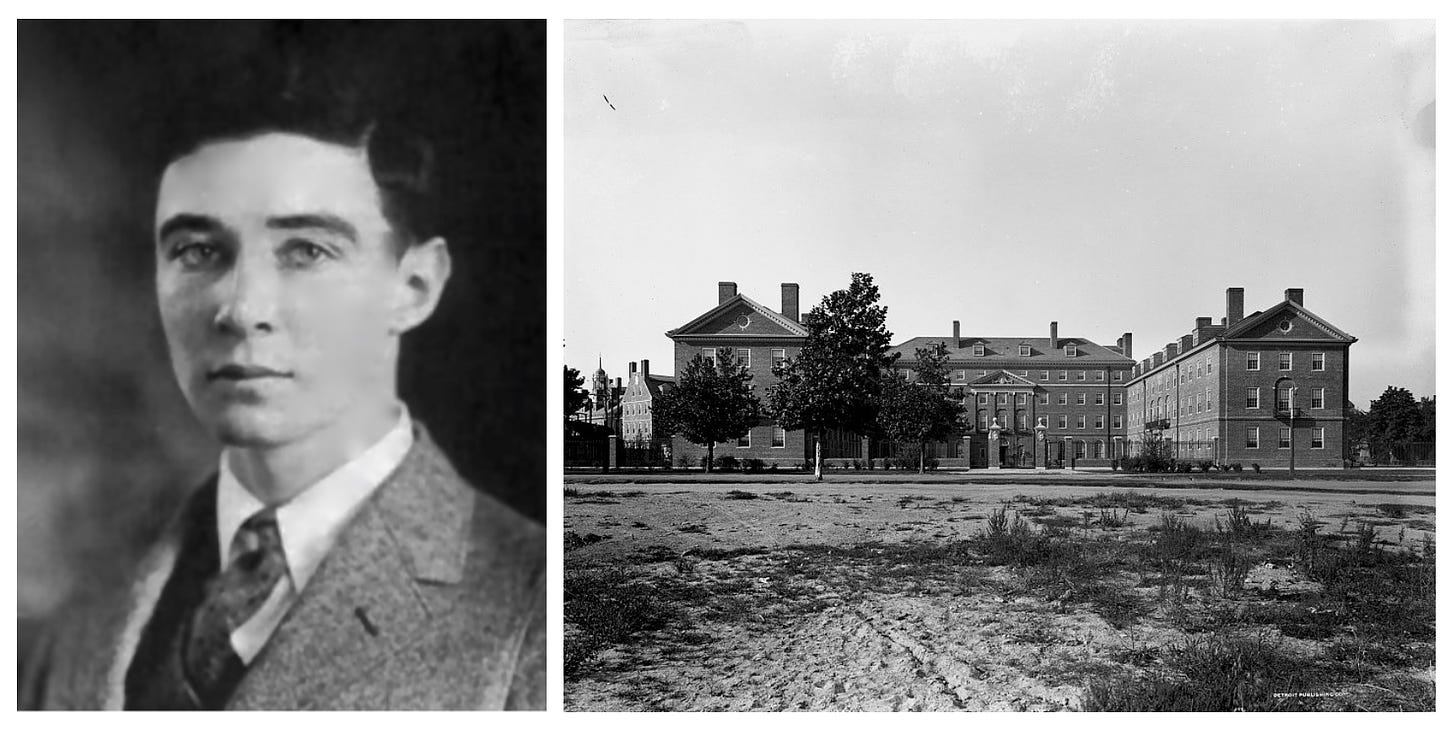
Compensating for his late (actually, regular) start at higher education, Oppenheimer took six courses each term, the maximum allowed. He picked a wide variety of unrelated courses, including philosophy, French literature, English, introductory calculus, as well as history. His major was chemistry. He applied himself diligently to his laboratory work, but also grew increasingly interested in theory. After a year or two, he petitioned the physics department to be allowed to enroll in graduate courses, citing a list of books he had read (Pais, 2006). Upon receiving the request, supposedly the member of the faculty handling his request said “Obviously he is a liar, but he should get a Ph.D. for even knowing their titles”.
“At Harvard I did a great deal; the maximum number of courses you could take was six but I audited two or three more in my third year […] the free availability of the whole library got me reading very widely.
I almost became alive”
Bird and Sherwin (2005) write that Oppenheimer’s approach to learning physics was “eclectic, even haphazard” in that he would focus himself in on the most interesting, (typically) abstract problems in the field, bypassing the basics. Even years later in 1965, he confessed that because of this method of learning, he still felt insecure about gaps in his knowledge.
“To this day, I get panicky when I think about a smoke ring or elastic vibrations. There’s nothing there — just a little skin over a hole”
Regardless, Oppenheimer graduated summa cum laude with the A.B. degree after three years of study, rather than the regular four, in 1925. He made the dean’s list and was one of thirty students selected for membership in Phi Beta Kappa, the oldest academic honor society in the United States.
At Cambridge University (1925–26)
In September 1925, Oppenheimer was admitted to Christ’s College at Cambridge University. He boarded a ship for England that same month, settling into an apartment he later called a “miserable hole”, taking all of his meals at the college and spending his days in a corner of Nobel Laureate J. J. Thomson’s basement laboratory making thin beryllium films for use in the study of electrons. Recalling his year there, he later expressed discontent with the state of physics in America at the time, stating
“I was still, in the bad sense of the word, a student. I didn’t learn about quantum mechanics until I got to Europe. I didn’t learn about electron spin until I got to Europe. I don’t believe that they were actually known in ’25 in the spring in America; anyway, I didn’t know them”
Upon first arriving in Cambridge, Oppenheimer had applied to study physics under Sir Ernest Rutherford (1871–1937), but been denied. “Rutherford wouldn’t have me. My credentials were peculiar and not impressive”. He was instead sent to Thomson, whom he worked under for a year, while attending theoretical seminars and catching up on contemporary journals, including the Zeitschrift für Physik. Oppenheimer later recalled being confronted with Heisenberg’s 1925 paper Über quantentheoretische Umdeutung kinematischer und mechanischer Beziehungen ("Quantum theoretical re-interpretation of kinematic and mechanical relations") while there,which laid the foundation for matrix mechanics, the first conceptually autonomous and logically consistent formulation of quantum mechanics:
“I remember not liking it. I think I was interested in what the hell the electrons were doing. I didn’t like the looseness of the relation between waves and events”
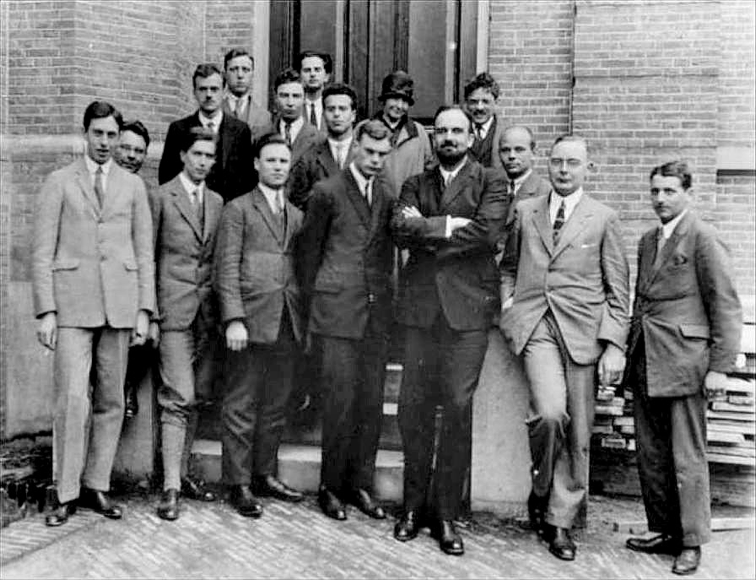
In general, biographers Bird and Sherwin (2005) describe a difficult period for Oppenheimer in Cambridge. Writing to his friend Francis Fergusson, Oppenheimer expressed “having a pretty bad time. The lab work is a terrible bore, and I am so bad at it that it is impossible to feel that I am learning anything . . . the lectures are vile.”
“His difficulties in the laboratory were compounded by his deteriorating emotional state. One day Robert caught himself staring at an empty blackboard with a piece of chalk in his hand, muttering over and over ‘The point is.. The point is.. The point is..’”.
— Excerpt, American Prometheus: The Triumph and Tragedy of J. Robert Oppenheimer*by Kai Bird & Martin J. Sherwin (2005)
Walking into his room one day, a friend caught Robert laying on the floor, groaning and rolling from side to side. By the end of the fall term, Fergusson concluded that Robert was experiencing a “first class case of depression”:
An episode occurred aboard a train that indicated that Robert was losing control emotionally. "He found himself in a third-class carriage with a man and woman who were making love, and though he tried to read thermodynamics he could not concentrate. When the man left Robert kissed the woman. She did not seem unduly surprised [...] but he was at once overcome with remorse, fell on his knees, his feet sprawling, and with many tears begged her pardon" [...] Assuming Fergusson accurately reported the story he was told, it seems clear that Robert was caught up in a fantasy.
— Excerpt, American Prometheus: The Triumph and Tragedy of J. Robert Oppenheimer*by Kai Bird & Martin J. Sherwin (2005)
Another disturbing event involving Fergusson occurred when Robert took a vacation from his studies and travelled to Paris. Fergusson noticed that Oppenheimer was feeling depressed. To help distract him, he told Oppenheimer that he was to marry his girlfriend. Oppenheimer did not take the news well. Rather, he jumped on Fergusson and tried to suffocate him. Although Fergusson easily fended off the attack (Oppenheimer weighed less than 130 lbs at the time), the episode cemented Fergusson’s impression of Oppenheimer as a person with deep psychological troubles.
The “Poisoned Apple” Incident
While still at Christ’s College Oppenheimer developed an antagonistic relationship with his tutor, the experimental physicist Patrick Blackett who was a few years his senior. Consumed by feelings of inadequacy and intense jealousy, he one day — according to Fergusson — poisoned an apple with chemicals from the laboratory and left it on Blackett’s desk. Fortunately Blackett didn’t eat the apple, but Cambridge got word of the story and concluded that if the alleged “poison” used was lethal, then what Robert had done amounted to attempted murder.
Luckily for Robert, his father Julius was in Cambridge and successfully lobbied the university to not press criminal charges. Instead, Oppenheimer was put on probation and required to see a psychiatrist in London regularly, which he did. The Freudian psychoanalyst who treated him would later diagnose him with dementia praecox, for symptoms now most closely associated with schizophrenia, writing in his records that he was a “hopeless case” whose “further analysis would do more harm than good” (Bird & Sherwin, 2005).
Although a rough period, Oppenheimer’s time in Cambridge was useful for his development as a physicist in that it enabled him to have close encounters with many of the world’s leading theoretical physicists, including Bohr, Dirac, Chadwick, Fowler, Ehrenfest, Uhlenbeck and Born. His first personal encounter with Niels Bohr (Robert had attended his lectures in Harvard) is said to have been characteristic of both men (Pais, 2006):
“When Rutherford introduced me to Bohr, he asked me what I was working on. I told him and he said, ‘How is it going?’ I said ‘I’m in difficulties.’ He said ‘Are the difficulties mathematical or physical?’ I said ‘I don’t know’. He said ‘That’s bad’”.
Reportedly, Bohr vividly remembered the encounter because Oppenheimer had looked unusually young and Rutherford had turned to him after he (Oppenheimer) left the room and remarked that he had high expectations of him. The outcome of his meetings with these great men, was Robert’s first two research papers, written in Cambridge and submitted for publication in May and July of 1926. Both papers dealt with quantum theory, the first with molecular spectra and the second with transitions to continuum states in hydrogenic atoms (Pais, 2006).
At Göttingen University (1926–27)
“The science is much better than at Cambridge and on the whole, probably the best to be found. I find the work hard, thank god, and almost pleasant”
A year after first arriving in England, Oppenheimer in September 1926 left Cambridge for the University of Göttingen, to study under physicist Max Born, whom he had met while still in Cambridge. At the time, Born had submitted but not yet published his paper Zur Quantenmechanik der Stoßvorgänge (“On the Quantum Mechanics of Collisions”) where he defined what is now known as the Born rule, giving the probability that a measurement on a quantum system will yield a given result. As the chairman of the physics department, Born had helped nurture the work of Heisenberg, Eugene Wigner, Wolfgang Pauli and Enrico Fermi. He had coined the term “quantum mechanics” and was the first to suggest that the outcome of any interaction at the scale of the quantum is determined by chance.

The timing of Oppenheimer’s arrival in Göttingen could not have been more ideal. Heisenberg’s breakthrough paper Über quantentheoretische Umdeutung kinematischer und mechanischer Beziehungen (“Quantum theoretical re-interpretation of kinematic and mechanical relations”) laying the foundations for matrix mechanics had been published in 1925 and Schrödinger’s equation describing the wave function of quantum-mechanical systems had been introduced in January with the 1926 publication Quantisierung als Eigenwertproblem (“Quantization as an Eigenvalue Problem”). Arriving in September, Oppenheimer came to collaborate with Born only months before the third (Born’s) monumental paper on quantum mechanics would be published and a year before the 1927 Fifth Solvay International Conference on Electrons and Photons in which Born and Heisenberg would proclaim quantum mechanics to be “complete and irrevocable”.
Safely there, Robert found accommodations in a villa owned by a Göttingen physician. Already fluent in German, he for the first time in his life came to feel a pleasant camaraderie with his fellow students and realized that he could actually learn from others, not just from books (Bird & Sherwin, 2005):
“Something which for me — more than most people — is important began to take place, namely, I began to have some conversations, […] something that I probably would not ever have gotten to if I’d been locked up in a room”
Although he still experienced bouts of anxiety and panic, once even fainting and falling to the floor in front of Paul Dirac, on the whole Robert thrived in Göttingen. By the time he arrived in the fall of 1926, his two first research papers had been published by the Cambridge Philosophical Society. The recognition that followed allowed him to engage himself enthusiastically in seminar discussions, often to the chagrin of other students. “He was a man of great talent […] and conscious of his superiority in a way that was embarrassing and led to trouble”.
Among his graduate students, Oppenheimer’s thesis supervisor Max Born was known to make small mistakes in his long calculations and so routinely asked them to recheck his math. When he once gave a set of calculations to Oppenheimer, Robert returned the work and said, apparently un-ironically, “I couldn’t find any mistake — did you really do this alone?” (Bird & Sherwin, 2005).
“Oppenheimer was the only [student] frank and rude enough to say it without joking. I was not offended; it actually increased my esteem for his remarkable personality” — Max Born
In the winter term of 1927, Paul Dirac arrived and found lodgings in the same villa as Robert. As Robert later stated “the most exciting time in my life was when Dirac arrived and gave me the proofs of his paper on the quantum theory of radiation”. Dirac, who was two years older had just completed his seminal paper on the principles of quantum mechanics. Oppenheimer later stated about Dirac that he was “was not easily understood, not concerned with being understood” adding “I thought he was absolutely grand”. Dirac, when later confronted with a statement from Robert that he saw more of him than anyone else in Göttingen, is to have replied with characteristic mercuriality that “That is so. We sometimes went for long walks together, although I had many walks alone” (Pais, 2006).
In the spring of 1927, Oppenheimer submitted his doctoral dissertation entitled Zur Quantentheorie kontinuierlicher Spektren (“On quantum theory of continuous spectra”), which Born recommended be accepted with distinction. The dissertation narrated a complicated calculation for the photoelectric effect in hydrogen and x-rays, later remarked by Nobel Laureate Hans Bethe as “even today still a complicated calculation, beyond the scope of most quantum mechanics textbooks”. Oppenheimer sat for his oral examination on May 11th of the same year. After the defense, the professor administering the session, 1925 Nobel Laureate James Franck reportedly emerged stating “I’m glad that’s over. He was at the point of questioning me.”
Research
In addition to his first two papers written in Cambridge, Oppenheimer would publish another seven papers on quantum physics while still at Göttingen, a incredible output for a 23-year-old graduate student (Bird & Sherwin, 2005). Impressed, Born on one occasion bragged to then-president of MIT Karl Taylor Compton about his student:
“We have here a number of Americans […] One man is quite excellent, Mr. Oppenheimer.”
Over the course of his career, Oppenheimer would publish 73 papers in total, ranging from topics in quantum field theory, particle physics, the theory of cosmic radiations, nuclear physics and cosmology. The following discoveries are amongst his most recognized:
The Born-Oppenheimer approximation (1927)
Prompted by a remark from Heisenberg, Robert in 1927 grew interested in using the new methods of quantum theory to explain, as he put it “why molecules were molecules” (Bird & Sherwin, 2005). Presenting his notes to Born, the professor agreed to collaborate on a paper explaining Oppenheimer’s new idea. In the paper, written while Robert was still in Göttingen, Born and Oppenheimer came to define what is now known as the Born-Oppenheimer approximation, in quantum chemistry and molecular physics the assumption that the motion of atomic nuclei and electrons in a molecule can be treated separately.
- Born, M. & Oppenheimer, J.R. (1927). Zur Quantentheorie der Molekeln (“On the Quantum Theory of Molecules“) in Annalen der Physik
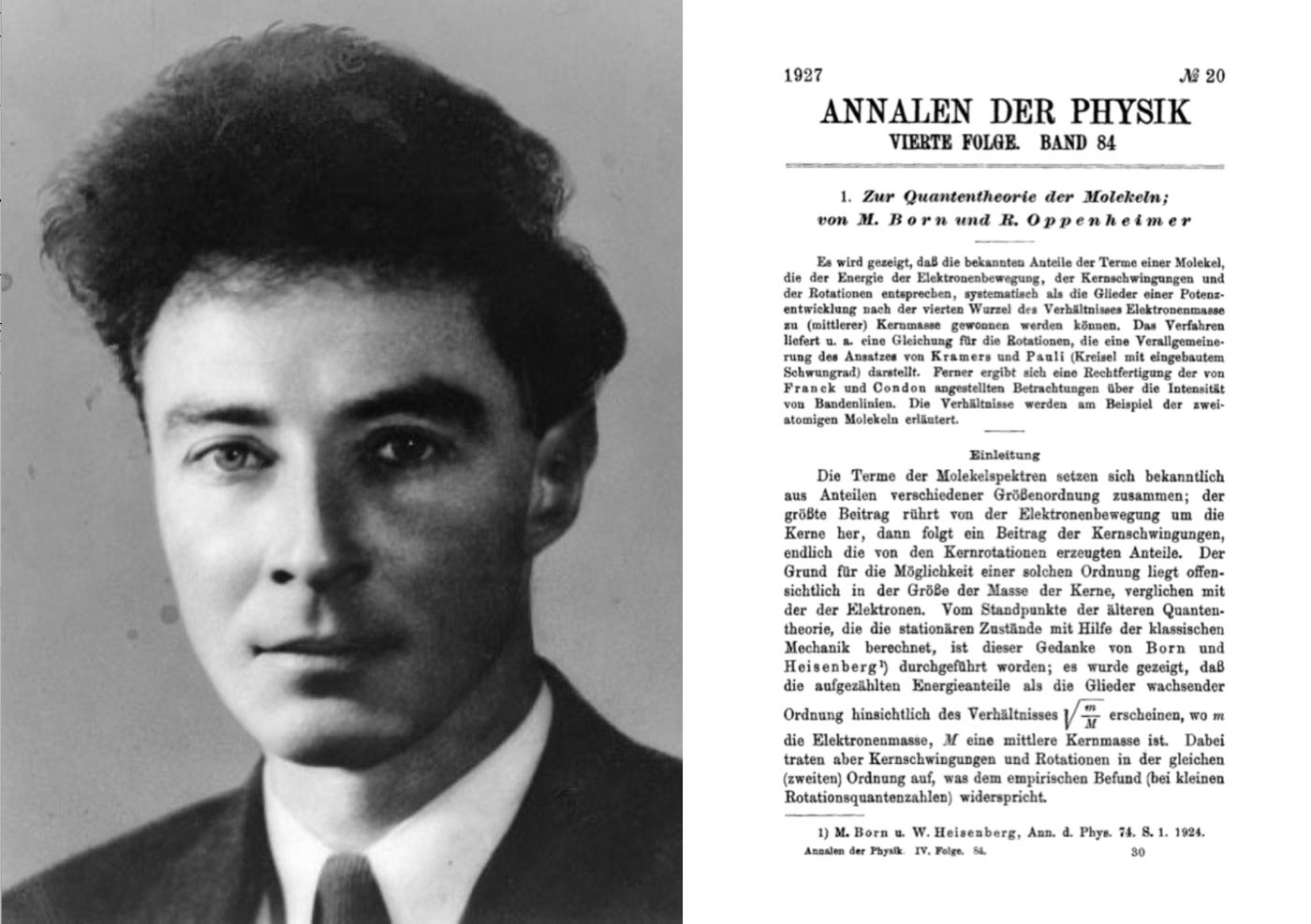
Following their completion of the paper and Robert’s successful oral defense of his dissertation, he soon after sailed for New York. A rising young star in the newly developed field of quantum theory, Oppenheimer had already been awarded a United States National Research Council fellowship to do post-doctoral work at the California Institute of Technology (Caltech). Before traveling to California, he returned briefly to Harvard in the fall of 1927. There he produced three papers:
- Oppenheimer, J. R. (1927a). On the quantum theory of the polarization of impact radiation in the Proceedings of the National Academy of Sciences 13 on the polarization of light excited by the electronic impact on atoms;
- Oppenheimer, J. R. (1927b). Three Notes on the Quantum Theory of Aperiodic Effects in Physical Review 31(1), a further elaboration of his work on continuous spectra; and
- Oppenheimer, J. R. (1927c). On the Quantum Theory of the Capture of Electrons in Physical Review 31(3), on the quantum mechanics of electron capture;
Oppenheimer eventually left for Pasadena, California in the beginning of 1928. Despite his teaching duties and the distractions of the California geological landscape (he still collected rocks), Oppenheimer managed to publish six papers his first year there, each dealing with aspects of quantum theory. Among them were
- Oppenheimer, J. R. (1928a). On the Quantum Theory of the Ramsauer Effect in Proceedings of the National Academy of Sciences 14 (3) where he addressed the phenomenon of scattering of low-energy electrons by atoms of a noble gas from a quantum perspective, the so-called Ramsauer-Townsend effect; and
- Oppenheimer, J. R. (1928b). On the Quantum Theory of the Autoelectric Field Currents in Proceedings of the National Academy of Science 14 (5) in which he proposed a theory of field emission, the first example of a quantum effect due to barrier penetration.
In the summer of 1929, Oppenheimer spent a month in Zurich where he worked under Pauli, then Professor of Theoretical Physics at ETH. In March of the same year, Heisenberg and Pauli had completed the first part of their joint work on quantum electrodynamics, the relativistic quantum field theory of electrodynamics. Oppenheimer, once again with impeccable timing, arrived just as the two were commencing with the second part of their work.
Using Pauli and Heisenberg’s young new theory, Oppenheimer commenced with addressing the so-called self-energy problem, to this day one of the most intractable issues in physics. The result was the discovery of a new source of self-energy, a quantum effect without a classical counterpart. He also observed that self-energy effects cause infinite displacements of atomic energy levels (Bird & Sherwin, 2005). These ideas were published in
- Oppenheimer, J.R. (1930). Note on the Theory of the Interaction of Field and Matter in Physical Review 35.
Back at Caltech, as a consequence of his considerable research output Oppenheimer began receiving job offers from other prominent American institutions. He eventually turned down an offer from Harvard, but found the prospect of living in Berkeley intriguing, as it reminded him of New Mexico:
"I visited Berkeley and I thought I'd like to go to Berkeley because it was a desert. There was no theoretical physics and I thought it would be nice to try to start something. [...] I liked it enough to want to come back and enough to feel that it was a place where I would be checked if I got too far off base and where I would learn of things that might not be adequately reflected in the published literature"
— Excerpt, J. Robert Oppenheimer: A Life* by Abraham Pais (2006)
And so Robert accepted UC Berkeley’s offer, turning down 11 other world-renowned universities. He negotiated to be able to also remain in his position at Caltech, and teach one semester at each school.
“If there ever was a period during which Robert was happy, those were his California years in the 1930s, I would think” — Abraham Pais
In 1931, he co-authored a paper with his student Harvey Hall entitled ‘Relativistic Theory of the Photoelectric Effect’ in which they based on empirical observations dispute that Dirac’s assertion that two of the energy levels of the hydrogen atoms have the same energy. Another of his doctoral students, Willis Lamb, later determined that this was a consequence of what is now known as the Lamb shift, for which he was awarded the Nobel Prize in 1965.
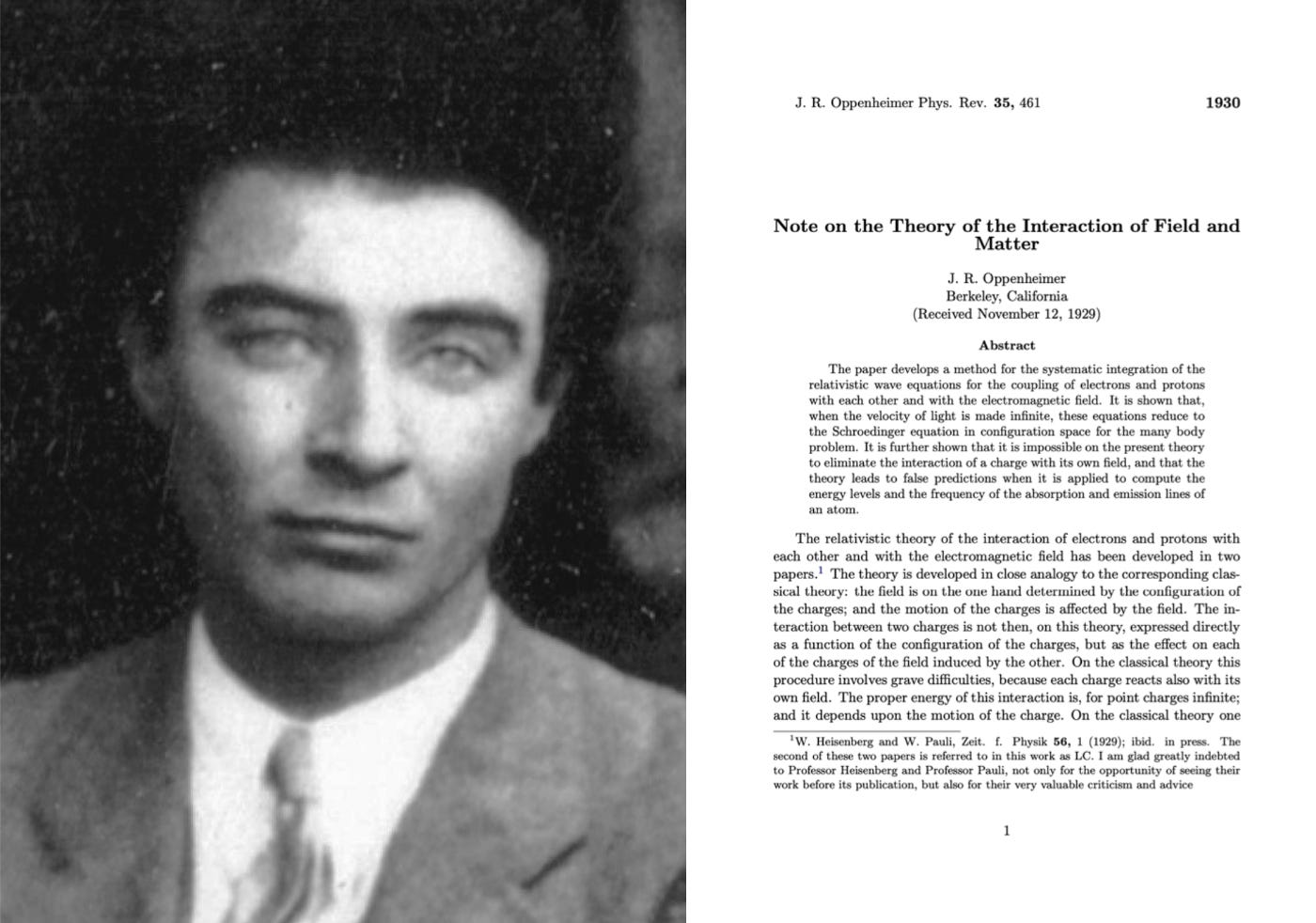
The Oppenheimer-Phillips process (1935)
By 1935, Robert was professor at the University of California, Berkeley. Together with his student Melba Phillips they published the paper Note on the Transmutation Function for Deuterons which appeared in Physical Review 48. The paper describes a type of deuteron-induced nuclear reaction wherein the neutron half of a stable isotope of hydrogen with one proton and one neutron fuses with a target nucleus, the target is transmuted to a heavier isotope while ejecting a proton. The process has since become known as the Oppenheimer-Phillips process, and successfully explains, for instance, the nuclear transformation of carbon-12 to carbon-13. The discovery was made from experiments conducted at the UC Berkeley cyclotron, which showed that some elements became radioactive under deuteron bombardment.
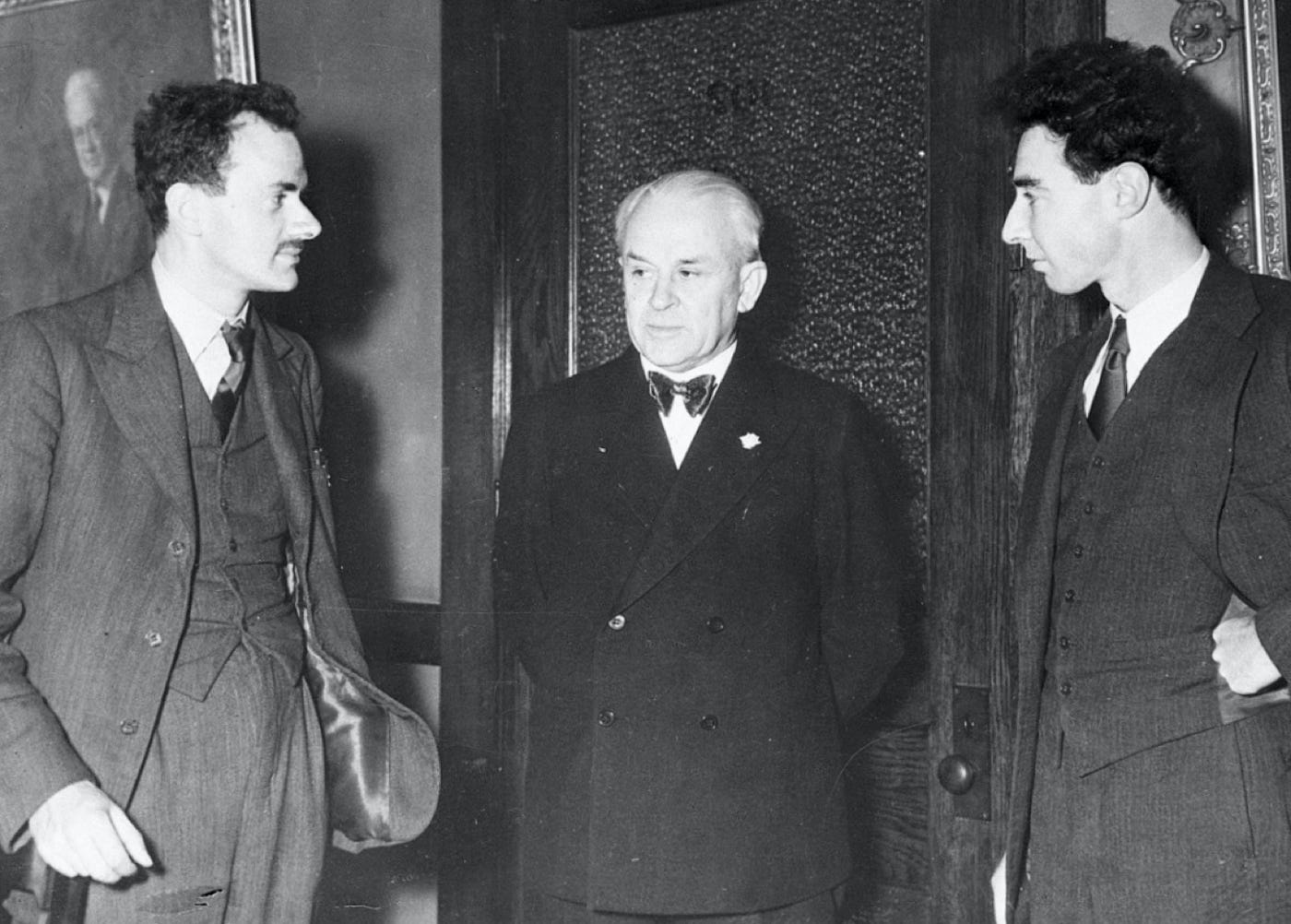
Through his friendship with Richard Tolman in the 1930s, Oppenheimer later also grew interested in astrophysics. His co-authored paper On Continued Gravitational Contraction in Physical Review 56 was written in collaboration with his student Hartland Snyder in 1939 and is the first published prediction of the existence of black holes (read: the Tolman-Oppenheimer-Volkoff limit). Of this contribution, largely unrelated to his previous work, physicist Freeman Dyson later wrote:
His theoretical prediction of black holes was by far his greatest scientific achievement, fundamental to the modern development of relativistic astrophysics, and yet he never showed the slightest interest in following it up. So far as I can tell, he never wanted to know whether black holes actually existed. [...] We know that the Oppenheimer-Snyder calculation is correct and describes what happens to massive stars at the end of their lives. It explains why black holes are abundant, and incidentally confirms the truth of Einstein's theory of general relativity. And still, Robert Oppenheimer was not interested. [...] How could he have remained blind to his greatest discovery? [...] Perhaps if the Oppenheimer-Snyder calculation had not happened to coincide with the Bohr-Wheeler theory of nuclear fission and with the outbreak of World War II, Robert would have paid more attention to it.
— Excerpt, The Scientist As Rebel (2006) by Freeman Dyson
The Manhattan Project (1942–45)
“Oppenheimer gave us an example of how large scientific enterprises can be more than the sum of the collaborative effort of their groups. They can be imbued with a creative spirit based upon a common heritage and a common aim” — Victor Weisskopf
If World War I was the “chemist’s war”, then World War II was certainly to become the “physicist’s war”. In the same year Oppenheimer was preoccupied with cosmology and published his paper predicting the existence of black holes, German nuclear physicists Otto Hahn and Fritz Strassmann reported the discovery of uranium fission in a 1939 issue of Die Naturwissenschaften, later identified as nuclear fission by Lise Meitner in the February 11th 1939 issue of Nature. The news of the discovery was brought to America by Niels Bohr and was soon empirically verified in the U.S. by Enrico Fermi at the University of Columbia.
Hungarian physicist Leó Szilárd who at the time was working in the United States, soon realized that the neutron-driven fission of heavy atoms could be used to create a nuclear chain reaction, yielding massive amounts of energy for electric power generation, and potentially, atomic bombs. Concerned that German scientists working under the Nazi regime might attempt to exploit the new discovery for bomb-making purposes Szilárd concluded that he should warn the Belgian government, as the Belgian Congo was the best source of uranium ore. He came to this conclusion after conferring with his compatriots Edward Teller and Eugene Wigner. As Albert Einstein — by then a world-renowned scientist and political activist — knew the Belgian Royal Family, Szilárd thought he would be the most suitable person to do this.
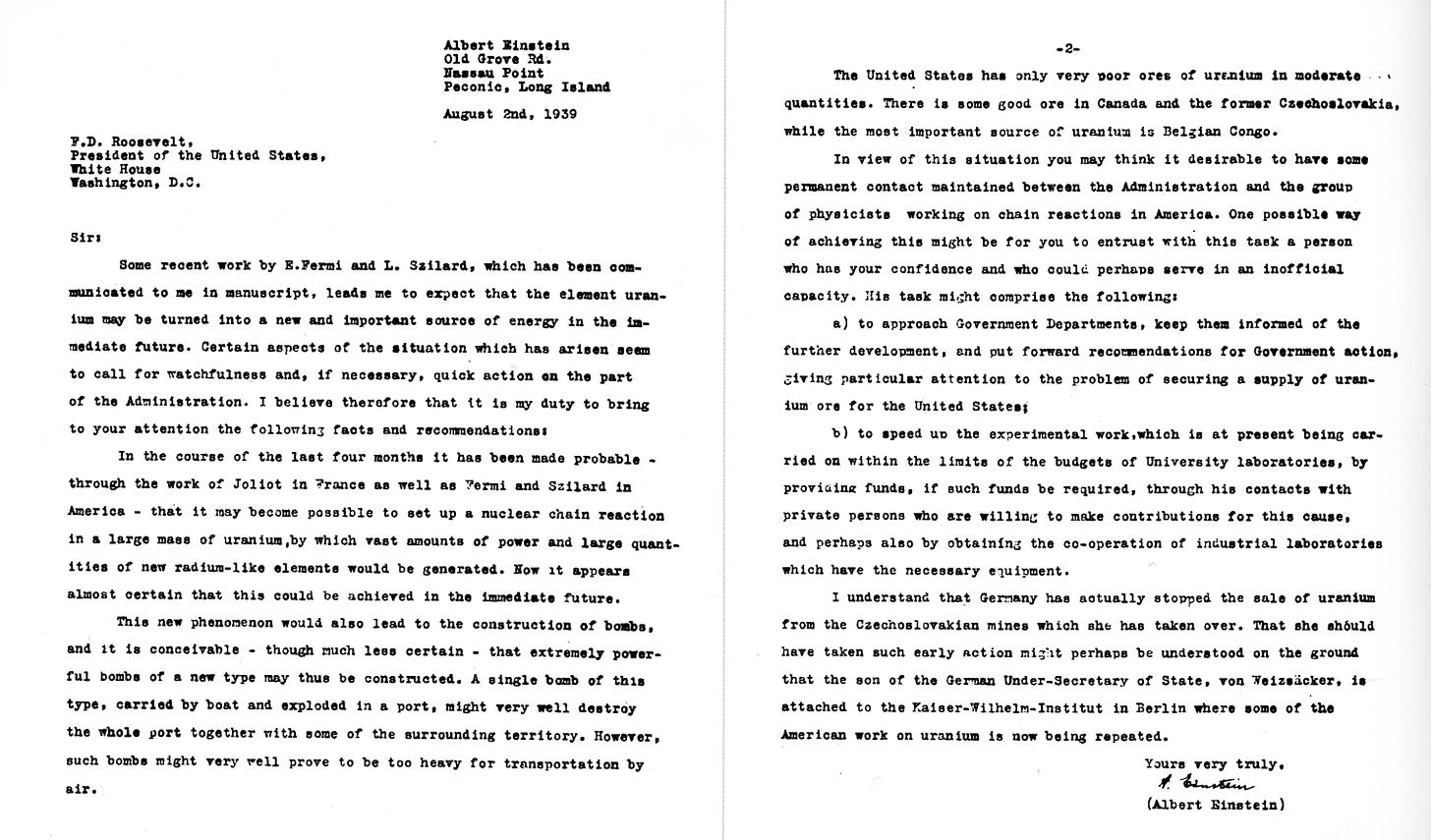
The now famous Einstein-Szilárd letter was sent to the Belgian Ambassador to the United States, as well as the President of the United States, Franklin D. Roosevelt on August 2nd, 1939. It argued that the United States should engage in uranium research. Upon reading the letter, Roosevelt decided that it required action, and so authorized the creation of an Advisory Committee on Uranium which included Szilárd, Teller and Wigner, as well as Harold C. Urey, Ernst O. Lawrence, James B. Conant, Lyman J. Briggs, E. V. Murphree and Arthur Compton. Read more about the Einstein-Szilárd letter here:

Oppenheimer’s involvement
Starting from 1934 and onward, Oppenheimer had become increasingly concerned with politics and international affairs. Following ‘the great purge of 1933' from Göttingen, in 1934 he began earmarking three percent of his annual salary — about $100 (equivalent to about $2000 in 2019) to support German physicists fleeing Nazi Germany.
The director of what had become the Manhattan project was Lieutenant General Leslie Groves (1896–1970), by the 1940s an officer of the Army Corps of Engineers. In 1942 Groves went looking for a director for what was then known simply as Project Y, which would actually attempt to build a nuclear bomb. Compton, a head of one of the projects’ many laboratories suggested Groves look into Oppenheimer, who was then the head of fast-neutron research at UC Berkeley. Groves did, and eventually appointed Oppenheimer to head the project’s bomb project.
“In a few weeks it became apparent that we were not going to find a better man; so Oppenheimer was asked to undertake the task”. — Leslie Groves
Although it had a director, Project Y had yet to find a location where it would conduct its research. Oak Ridge, Tennessee was considered, as was Reno Nevada, but on Oppenheimer’s suggestion the search was narrowed to the vicinity of Albuquerque, New Mexico where he owned a ranch.
Oppenheimer’s love of New Mexico can be traced back all the way to the summer of 1922 when after his first bout of colitis, he travelled to New Mexico to stay with his friend Fergusson’s family in Albuquerque. There, Oppenheimer fell in love with the outdoor desert life, the open vistas and horseback riding. He later described traveling across the trails of the Sangre de Cristo Mountains on horseback as “magical”.
The laboratory set up its operations in the spring of 1943 under Oppenheimer’s direction. In recruiting scientists to the project, Oppenheimer naturally drew on the connections he had made as a researcher up until that point, involving researchers from his own group at UCB as well as from the University of Minnesota and Wisconsin, Stanford and Purdue, Hans Bethe and Robert Bacher from the Radiation Laboratory at MIT, Edward Teller, Oppenheimer’s former student Robert F. Christy, and Robert R. Wilson’s group at Princeton (which included Richard Feynman) and many others. All told, the organization at Los Alamos counted 670 people, 200 of which were women, including Robert’s by-then wife Katherine “Kitty” Oppenheimer.
Of Oppenheimer’s role at Los Alamos, physicist and Group Leader of the Theoretical Division of the Manhattan Project Victor Weisskopf later recalled:
Oppenheimer directed these studies, theoretical and experimental, in the real sense of the words. Here his uncanny speed in grasping the main points of any subject was a decisive factor; he could acquaint himself with the essential details of every part of the work.
He did not direct from the head office. He was intellectually and physically present at each decisive step. He was present in the laboratory or in the seminar rooms, when a new effect was measured, when a new idea was conceived. It was not that he contributed so many ideas or suggestions; he did so sometimes, but his main influence came from something else. It was his continuous and intense presence, which produced a sense of direct participation in all of us; it created that unique atmosphere of enthusiasm and challenge that pervaded the place throughout its time.
— Excerpt, The Road from Los Alamos by Hans Bethe (1968)
“His function here [at Los Alamos] was not to do penetrating original research but to inspire it. It required a surpassing knowledge of science and of scientists […] A lesser man could not have done it. Scientists are not necessarily cultured, especially in America. Oppenheimer had to be.” — James Tuck
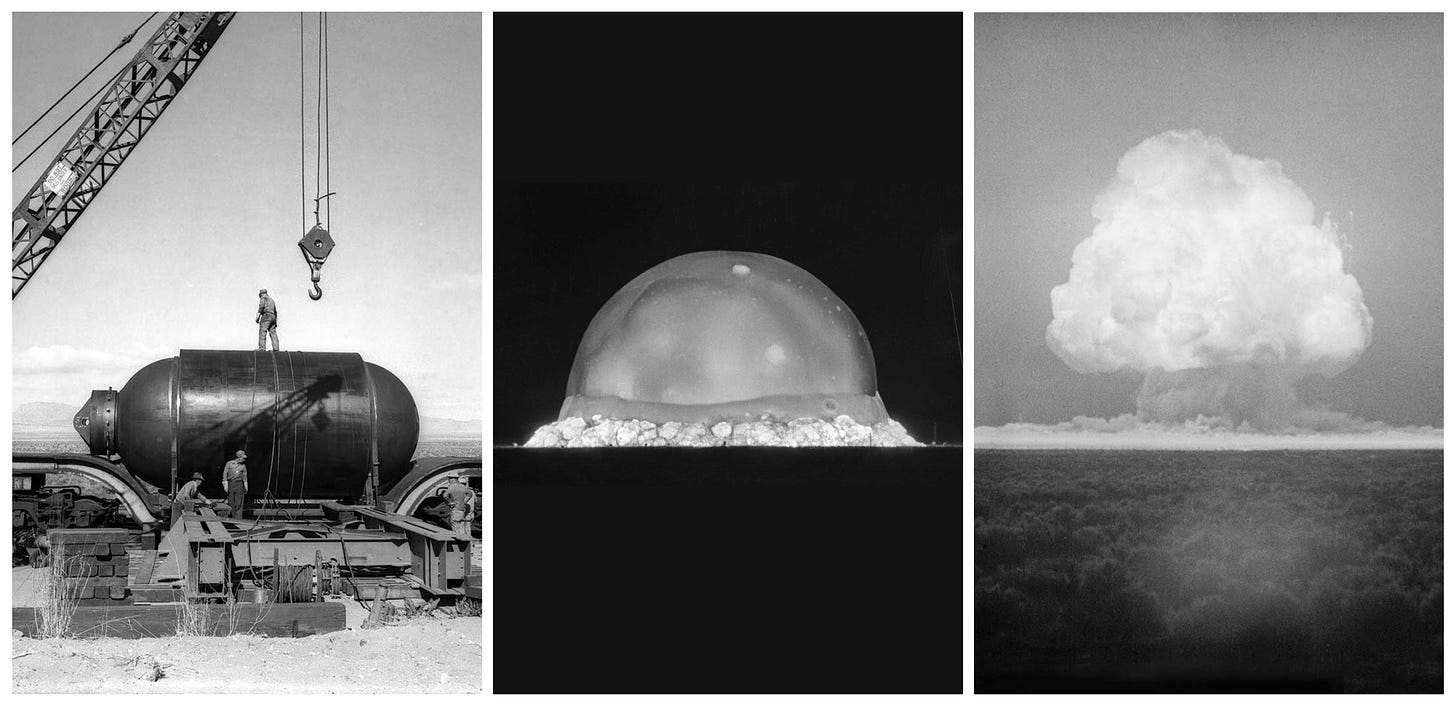
Trinity Test (July 16th 1945 at 05:29 am)
The first detonation of a nuclear device in history was conducted at 05:29am on July 16th 1945 in the Jornada del Muerto desert, 56 kilometers southeast of Socorro, New Mexico. Oppenheimer’s codename for the detonation, Trinity, was inspired by the poem “Holy Sonnet XIV: Batter My Heart, Three-Personed God” by English poet John Donne. When later asked of the codename’s origins by Groves, Oppenheimer’s response was the following:
“There is a poem of John Donne, written just before his death, which I know and love. From it a quotation:
As West and East
In all flat Maps—and I am one—are one,
So death doth touch the Resurrection.
That still does not make a Trinity, but in another, better known devotional poem Donne opens,
‘Batter my heart, three person’d God.’”
And so this site – where the intense heat of man’s first nuclear explosion would transmute sand into glass – would forever be known as Trinity.”
— Excerpt, The Making of the Atomic Bomb by Richard Rhodes (1986)
The test object detonated was a Fat Man, a five-kiloton plutonium bomb similar to that which was eventually dropped over Nagasaki. Prior to the detonation the observing scientists famously set up a betting pool on the results of the tests in terms of its magnitude. Edward Teller was the most optimistic, predicting a blast equivalent to 45 kilotons of TNT. Isidor Rabi predicted 18 kilotons, Bethe 8 kilotons and Robert a mere 0.3 kilotons of TNT. The blast produced an explosion equivalent to 22 kilotons of TNT, winning Rabi the pool. While witnessing the explosion Oppenheimer later recalled that he thought of the following verse from the Bhagavad Gita:
“If the radiance of a thousand suns were to burst at once into the sky, that would be like the splendor of the mighty one”
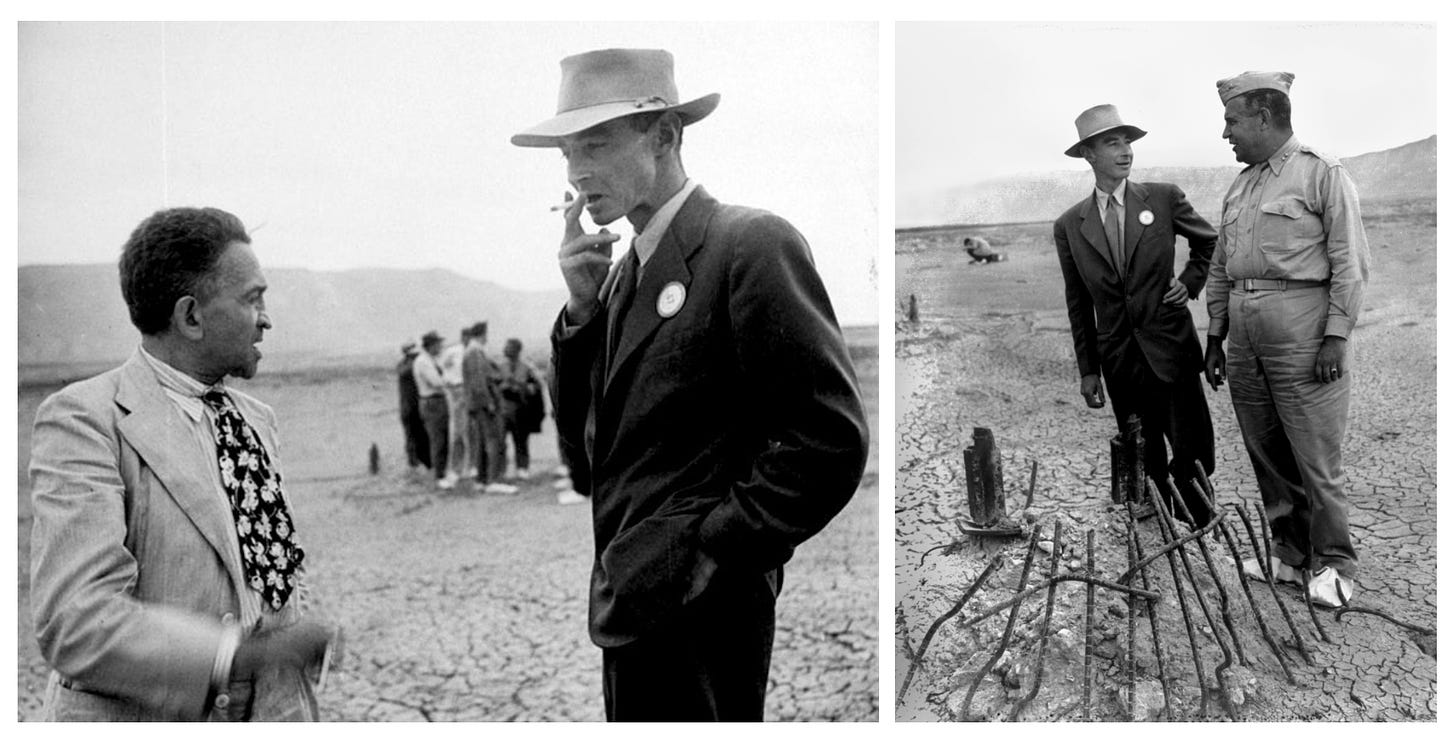
Some years after the blast, Oppenheimer reflected on the explosion, recounted in the book “In the Matter of J. Robert Oppenheimer”:
It was a success. I believe that in the eyes of the War Department, and other knowledgeable people, it was as early a success as they had thought possible, given all the circumstances, and rather a greater one. There were many indications from the secretary of war and General Groves, and many others, that official opinion was one of satisfaction with what had been accomplished. At the time, it was hard for us in Los Alamos not to share that satisfaction, and hard for me not to accept the conclusion that I had managed the enterprise well and played a key part in its success. But it needs to be stated that many others contributed the decisive ideas and carried out the work which led to this success and that my role was that of understanding, encouraging, suggesting and deciding. It was the very opposite of a one-man show.
— Excerpt, In the Matter of J. Robert Oppenheimer by the United States Atomic Energy Commission and J. Robert Oppenheimer
Because they had a “great gentleman to serve under”, the Los Alamos scientists invariably “remembered that golden time with enormous emotion”. — James Tuck
After Hiroshima and Nagasaki
About a month after Trinity, on August the 6th and 9th 1945, the United States detonated the first two nuclear weapons over the Japanese cities of Hiroshima and Nagasaki, killing between 129,000 and 226,000 people, most of whom were civilians and about half of whom died on the day the bombs were dropped.
Not two weeks later, Oppenheimer was in Washington DC, carrying a report on the matters of atomic weaponry to the Secretary of War Harry Stimson (1867–1950). In the letter, Oppenheimer addresses the future developments of atomic weapons as well as the consequence of the existence of atomic weapons on warfare — namely, that atomic weapons “make future wars impossible”
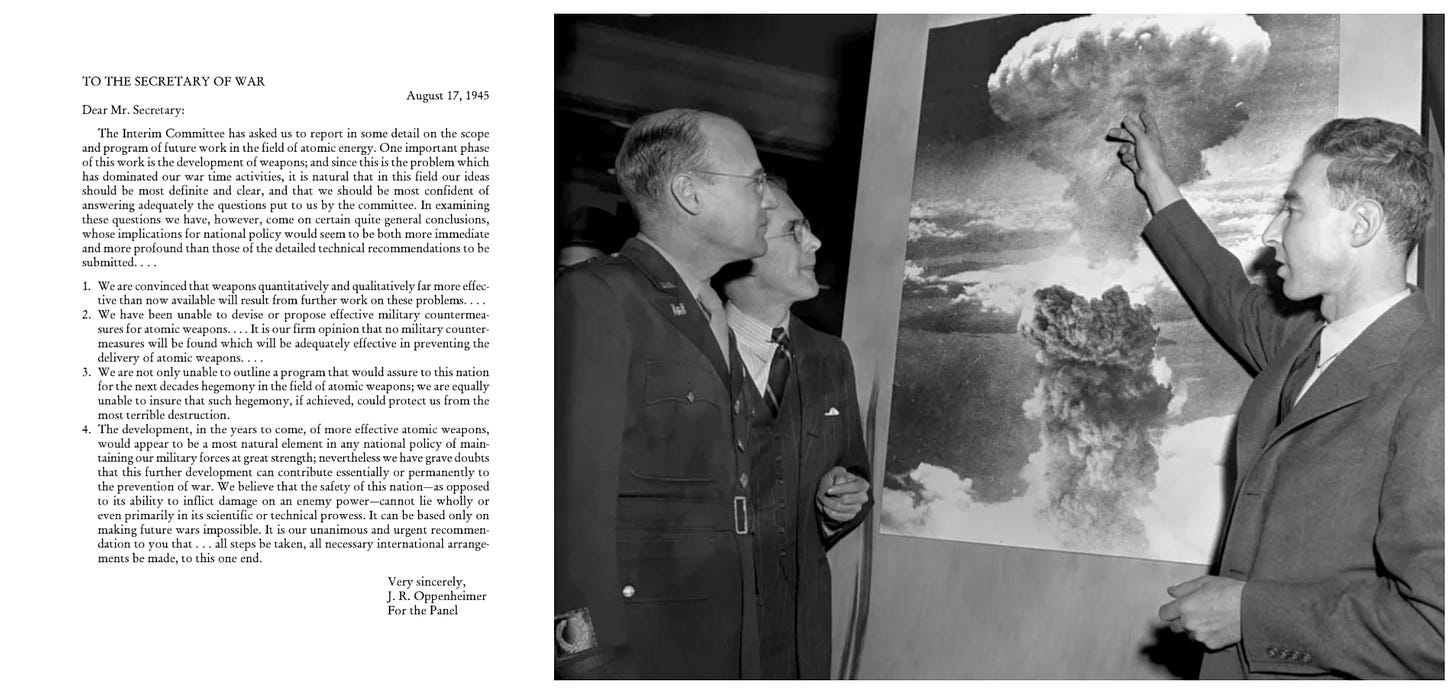
“It is our unanimous and urgent recommendation to you that . . . all steps be taken, all necessary international arrangements be made, to this one end.”
In 1965, at the height of the Cold War, Oppenheimer was interviewed for the NBC television program The Decision to Drop the Bomb about his involvement in the Manhattan Project and the development of atomic weaponry. By then 61 years old, Robert’s remarks on the scientists’ reaction to the first nuclear detonation are by now well-known:
Transcript
We knew the world would not be the same. A few people laughed, a few people cried, most people were silent. I remembered the line from the Hindu scripture, the Bhagavad-Gita. Vishnu is trying to persuade the Prince that he should do his duty and to impress him takes on his multi-armed form and says, “Now, I am become Death, the destroyer of worlds.” I suppose we all thought that one way or another.
Following the bombing in August of 1945, Oppenheimer was in October granted an audience with Harry S. Truman, in which he stated that he felt regret for developing the bomb, and stated that he had “blood on his hands”. The comment infuriated the president, who stood up to signal that the meeting was over. Afterwards, the President reportedly told Dean Acheson that “I don’t want to see that son-of-a-bitch in this office ever again” (Bird & Sherwin, 2005).
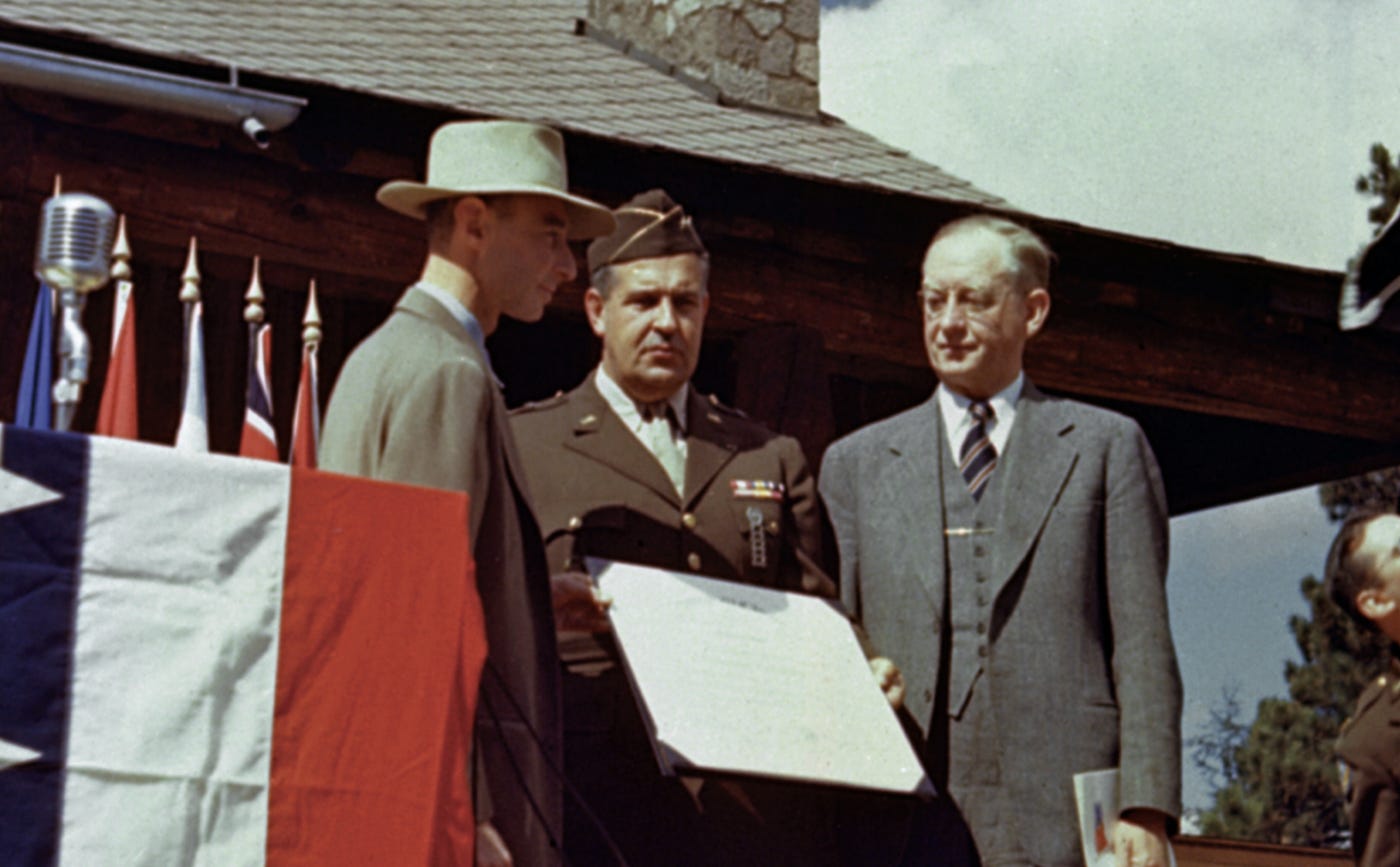
The Institute for Advanced Study (1947–66)
A man ablaze with power.
Returning to the California Institute of Technology in November 1945, Oppenheimer soon realized that his heart was no longer in teaching and research. He only published five scientific papers after the war. Instead — having succeeded as scientific director at Los Alamos in the preceding three years — Oppenheimer accepted a similar position albeit in civil society, the directorship of the Institute of Advanced Study (IAS) in Princeton, New Jersey.
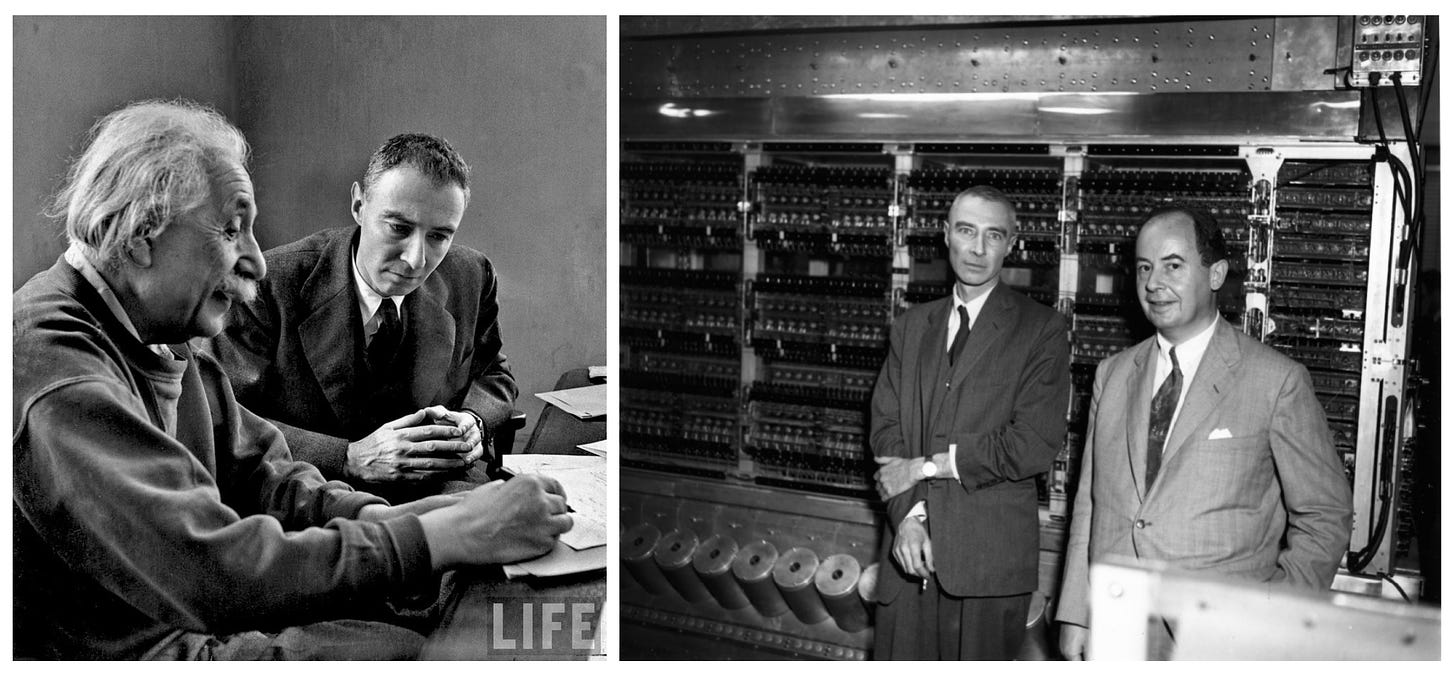
The directorship came with a salary of $20,000 per year and rent-free accommodations in the director’s house Olden Manor, a 17th-century mansion called surrounded by 265 acres of woodlands and a cook and groundskeeper. Oppenheimer’s office in room 113 of Fuld Hall was on the ground floor with a view of the woods and a meadow. His predecessor had decorated the walls with prints of wistful scenes of Oxford. Oppenheimer removed these and instead replaced them with a wall-to-wall blackboard.
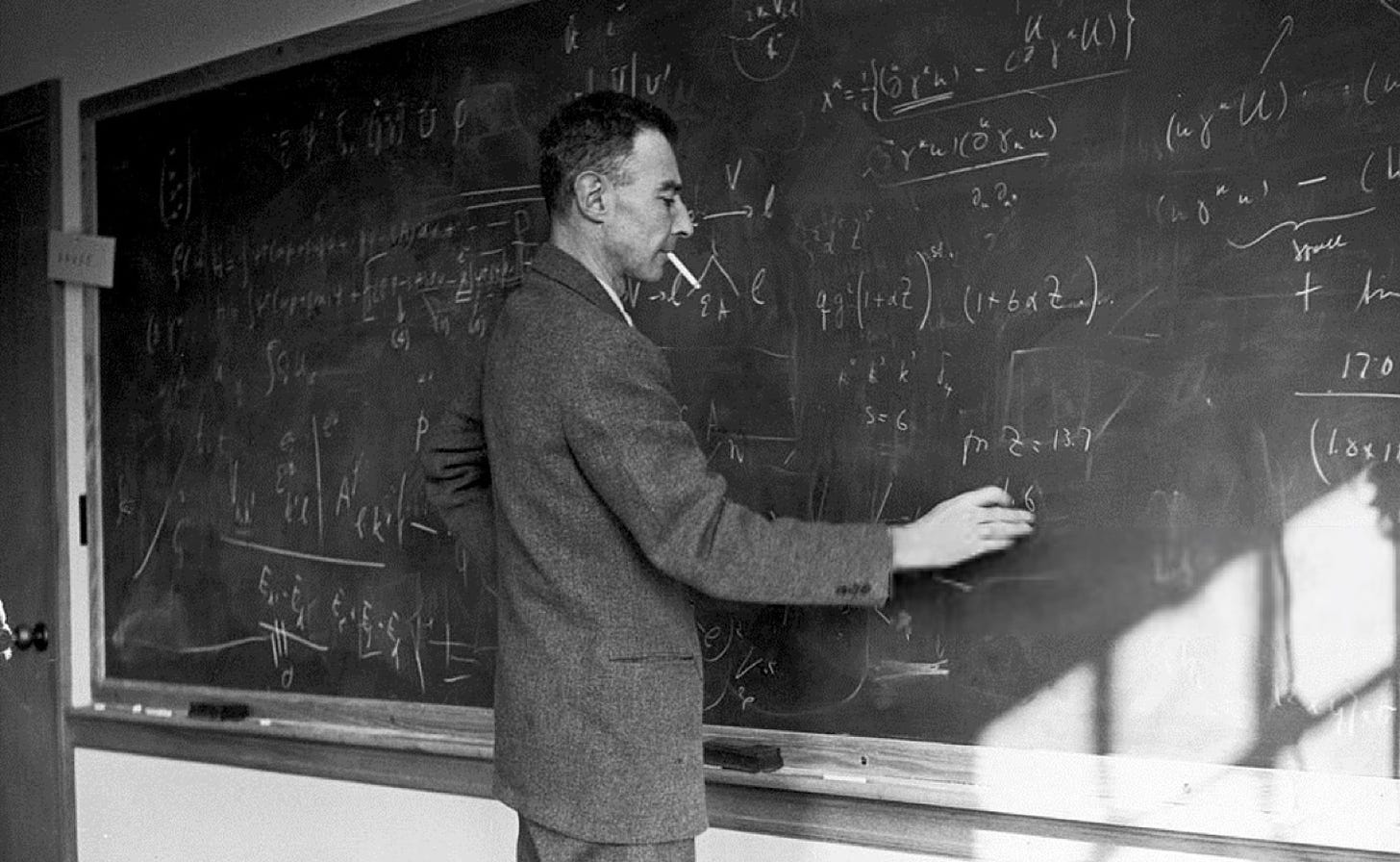
At the time of Oppenheimer’s arrival, the faculty of the institute included the likes of emeritus Albert Einstein (1879–1955), John von Neumann (1903–1957), Kurt Gödel (1906–1978), emeritus Oswald Veblen (1880–1960) and Hermann Weyl (1885–1955). Einstein occupied a corner office on the second floor, room 225. In 1947, Oppenheimer’s friends Niels Bohr and Paul Dirac (both visiting fellows at the time) worked in adjacent rooms on the third floor.
FBI investigation
Starting as early as in 1949, Oppenheimer was required to testify before the House Un-American Activities Committee, describing his loose affiliations with the American Communist Party in the 1930s. As a consequence of the McCarthy witch hunt that would follow in the 1950s, Oppenheimer suffered the revocation of his security clearance in a much-publicized security hearing in 1954 following an FBI investigation lead by J. Edgar Hoover.
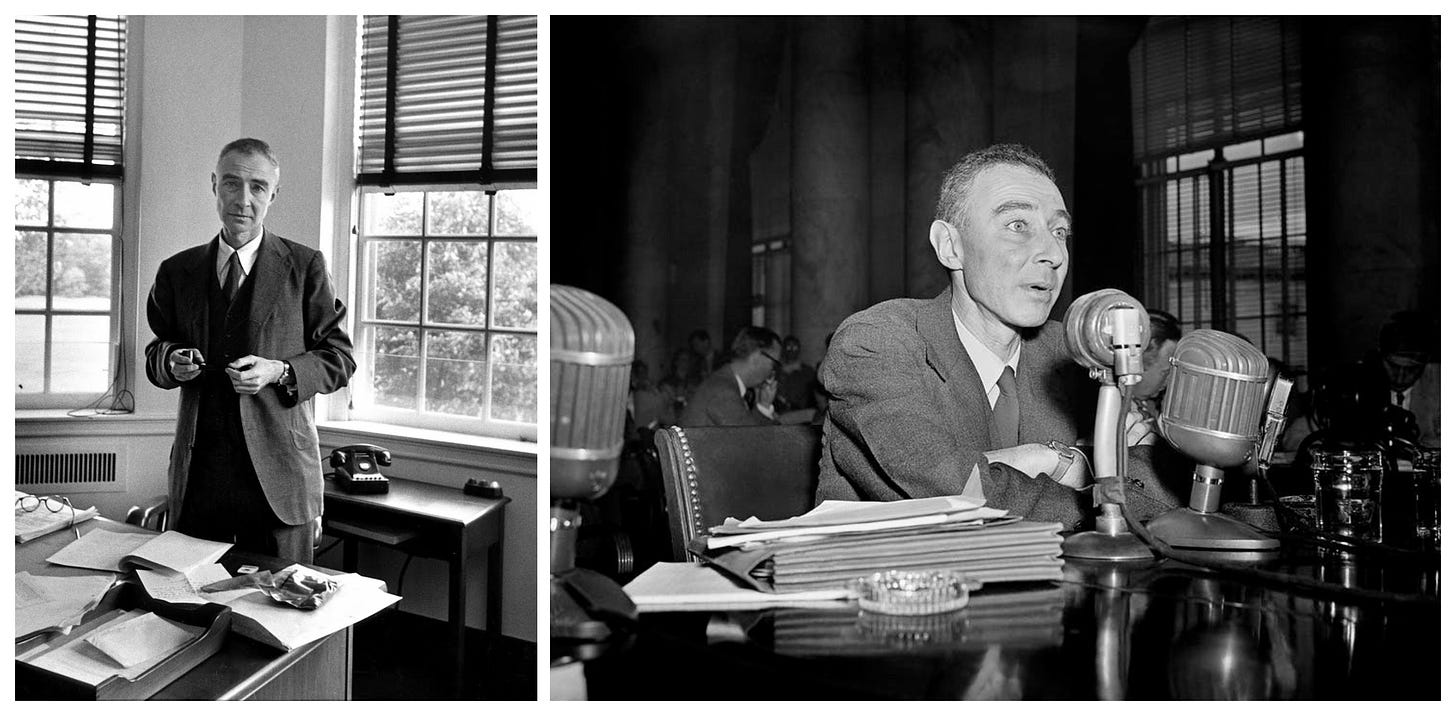
Oppenheimer’s decision to participate in the creation of a genocidal weapon was a Faustian bargain if there ever was one [...] And of course we’re still living with it [...]. And like Faust, Robert Oppenheimer tried to renegotiate the bargain — and was cut down for doing so. He had led the effort to unleash the power of the atom, but when he sought to warn his countrymen of its dangers, to constrain America’s reliance on nuclear weapons, the government questioned his loyalty and put him on trial.
— Freeman Dyson in The Day After Trinity: J. Robert Oppenheimer & the atomic bomb by Jon Else (1980)
Tragically, Oppenheimer’s associate Edward Teller chose to testify on behalf of the government at the hearing, to the dismay of most of their mutual colleagues in the scientific community:
In a great number of cases, I have seen Dr. Oppenheimer act, I understand that Dr. Oppenheimer acted, in a way which was for me was exceedingly hard to understand. I thoroughly disagreed with him in numerous issues and his actions frankly appeared to me confused and complicated. To this extent I feel that I would like to see the vital interests of this country in hands which I understand better, and therefore trust more. In this very limited sense I would like to express a feeling that I would feel personally more secure if public matters would rest in other hands.
— Edward Teller, testimony
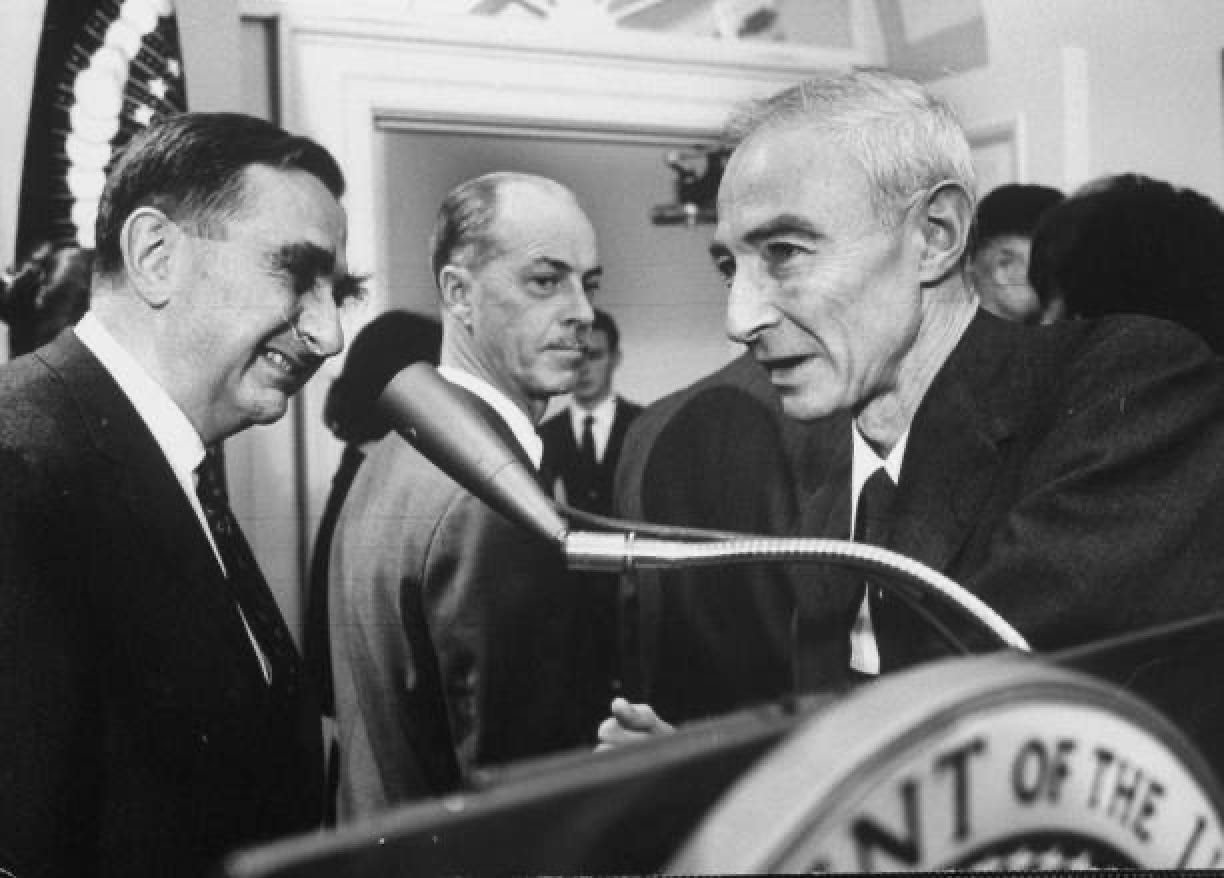
Personality
“To try to be happy is to try to build a machine with no other specification than that it shall run noiselessly.”
Throughout his life Oppenheimer was renowned for his extraordinarily gifted yet eccentric mind. The later Nobel Laureate Murray Gell-Mann who worked with Oppenheimer at the Institute for Advanced Study in 1951 once stated about Oppenheimer that “He didn’t have Sitzfleisch, ‘sitting flesh,’ when you sit on a chair. As far as I know, he never wrote a long paper or did a long calculation, anything of that kind. He didn’t have patience for that; his own work consisted of little aperçus, but quite brilliant ones. But he inspired other people to do things, and his influence was fantastic.”
“Even at Los Alamos, Oppenheimer didn’t talk about weapons or physics. He talked about the mystery of life […] He would rub his palms together and look to the side […] He kept quoting the Bhagavad Gita” — Charles Critchfield
In 1933, at the age of 29, Oppenheimer taught himself Sanskrit so that he could read the Hindu religious text Bhagavad Gita in its original text. He later cited it as one of the books that most shaped his views on the philosophy of life. Regarding this interest, Nobel Laureate Isidor Rabi would later state:
Oppenheimer was overeducated in fields which lie outside the scientific tradition, such as his interest in religion, in the Hindu religion in particular, which resulted in a feeling of mystery of the universe that surrounded him like a fog. He saw physics clearly, looking toward what had already been done, but at the border he tended to feel there was much more of the mysterious and the novel than there actually was
— Excerpt, Oppenheimer (1969) by Isidor Rabi
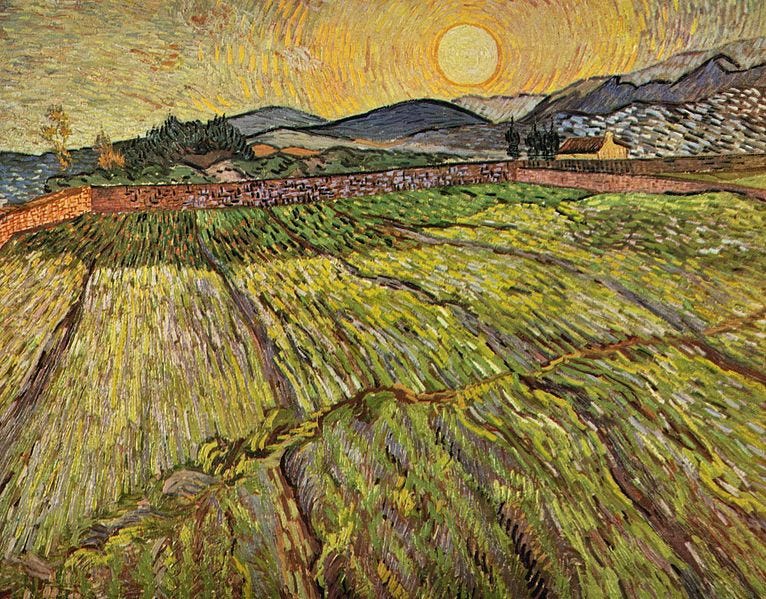
A highly educated physicist, Oppenheimer’s interests were unusually broad. As his mother Ella before him, Oppenheimer was an ardent collector of art and furniture. In particular, he was fond of French post-impressionist and Fauvist paintings, and owned original paintings by Cézanne, Picasso, Rembrandt, Renoir and Van Gogh, among other works. Robert was also fond of fashion and design, which was obvious to those around him:
He clearly relished the role history had assigned him and tried hard to play the part well. While most of the Institute's permanent scholars walked around in sports jackets (Einstein favored a rumpled sweater), Oppenheimer often wore expensive English wool suits hand-tailored for him and Langrocks, the local tailor for Princeton's upper crust. [...] Where many scholars got around Princeton on bicycles, Oppie drove a stunning blue Cadillac convertible. Where once he'd worn his hair long and bushy, now he had it "cut like a monk's, skin-tight."
— Excerpt, American Prometheus: The Triumph and Tragedy of J. Robert Oppenheimer*by Kai Bird & Martin J. Sherwin (2005)
Eccentricity
Oppenheimer was a “tall, thin chain smoker”, who often neglected to eat during periods of intense thought and concentration. Throughout his life, he was plagued by periods of depression, and he once told his brother that “I need physics more than friends”. Many of his friends described him as having self-destructive tendencies.
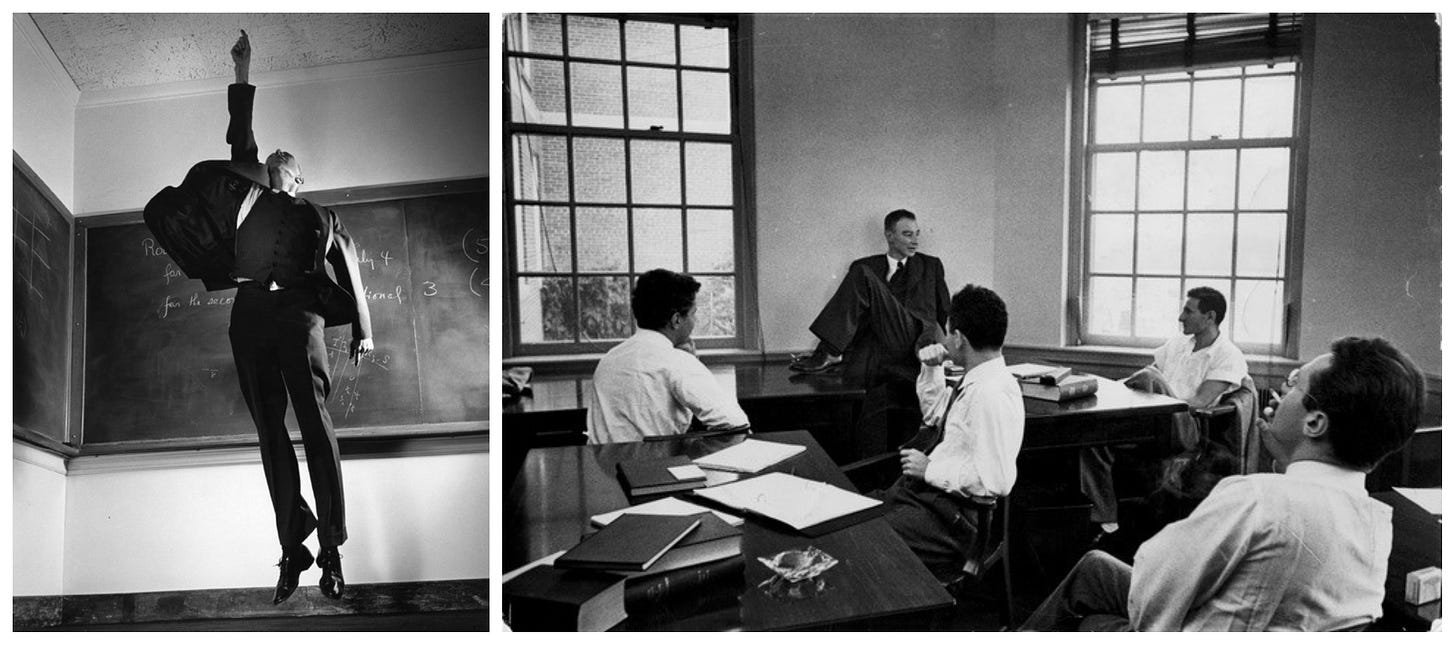
As early as in his teens, Oppenheimer was singled out as different from his contemporaries. Even his physical appearance drew the attention of those around him:
At nineteen, Robert was an oddly handsome young man. Every feature of his body was of an extreme. His fine pale skin was drawn taut across high cheekbones. His eyes were the brightest pale blue, but his eyebrows were glossy black. He wore his coarse, kinky black hair long on top, but short on the sides, so he seemed even taller than his lanky five feet, ten-inch frame. [...] His diet often consisted of little more than chocolate, beer and artichokes. Lunch was often just a "black and tan", a piece of toast slathered with peanut butter and topped with chocolate syrup. [...] He weighed so little, never more than 130 pounds, that he gave an impression of flimsiness. As he talked, his long, thin hands made his gestures seem somehow contorted.
— Excerpt, American Prometheus: The Triumph and Tragedy of J. Robert Oppenheimer*by Kai Bird & Martin J. Sherwin (2005)
While in Göttingen, Robert got into the habit of working until early in the morning before sleeping until late in the afternoon. Dressed in expensive clothing, he walked around with a chronic cough attributable both to his frequent colds and his chain-smoking (Bird & Sherwin, 2005), which developed into a life-long habit:
“At forty-three, he seemed delicate, even frail. […] He was very thin, nervous, jittery. He constantly moved around; he couldn’t sit still for five seconds; you had the impression of somebody who was tremendously ill at ease. He smoked all the time” — Freeman Dyson
As a young professor at UC Berkeley, Oppenheimer briefly dated his graduate student Melba Phillips, who he co-developed the Oppenheimer-Phillips process with. On one date, Robert drove her up the Berkeley hills to look at the view of the San Francisco Bay. After wrapping her in a blanket, Oppenheimer is to have said: “I’ll be back presently, I’m going for a walk”. When he came back, Phillips had fallen asleep. Oppenheimer didn’t notice, but announced: “Melba, I think I’ll walk on down to the house, why don’t you bring the car down?” and left again. When he hadn’t returned for two hours, Melba got worried and contacted a nearby policeman who initiated a search and rescue operation which eventually found Oppenheimer asleep in his bed. Apologetic, he explained that he had forgotten all about his date (Bird & Sherwin, 2005).
“I’m awfully erratic, you know. I just walked and walked — and I was home and I went to bed. I’m so sorry.”
The story was later reported on the front page of the San Francisco Chronicle and syndicated around the world under the headline “Forgetful Prof Parks Girl, Takes Self Home”.
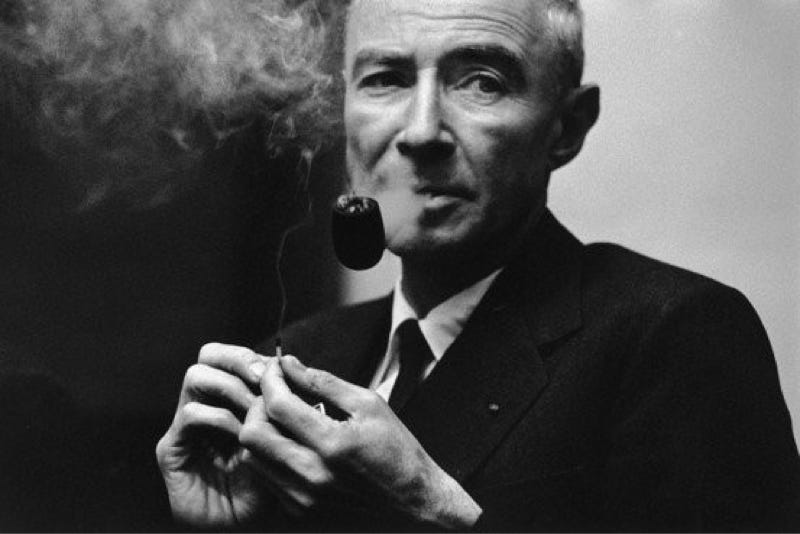
During his time in Berkeley in the 1930s, Robert’s closest confidant was Robert Serber, an American physicist who later participated in the Manhattan Project. He described Oppenheimer’s approach to teaching in the following way:
Oppie was quick, impatient, and had a sharp tongue. In the earliest days of his teaching he was reputed to have terrorized the students. [...] After five years of experience, he had mellowed, if his earlier students were to be believed. His course was an inspirational as well as an educational achievement. He transmitted to his students a feeling of the beauty of the logical structure of physics and an excitement in the development of science. Almost everyone listened to the course more than once, and Oppie occasionally had difficulty in preventing students from coming a third time. One Russian woman attempted to come a fourth time, and defeated Oppie's efforts to dissuade her by going on a hunger strike. [His students] carried [the course], each in his own version, to many campuses.
Oppie's way of working with his research students was also original. His group would consist of eight or ten graduate students and about a half dozen postdoctoral fellows. He would meet the group once a day in his office. A little before the appointed time its members would straggle in and dispose themselves on the tables and about the walls. Oppie would come in and discuss with one after another the status of the student's research problem, while the others listened and offered comments. All were exposed to a broad range of topics. Oppenheimer was interested in everything, and one subject after another was introduced and coexisted with all the others.
— Excerpt, Peace and War* by Serber and Crease (1998)
Oppenheimer met his future wife Katherine “Kitty” Puening in August of 1939. A radical student at UC Berkeley, Kitty was a former Communist Party member and had already been married before. A botanist, she was the ex-wife of activist Joe Dallet. Together, Robert and Kitty had two children. Peter Oppenheimer was born in 1941 and Katherine (“Toni”) Oppenheimer, born in 1944.
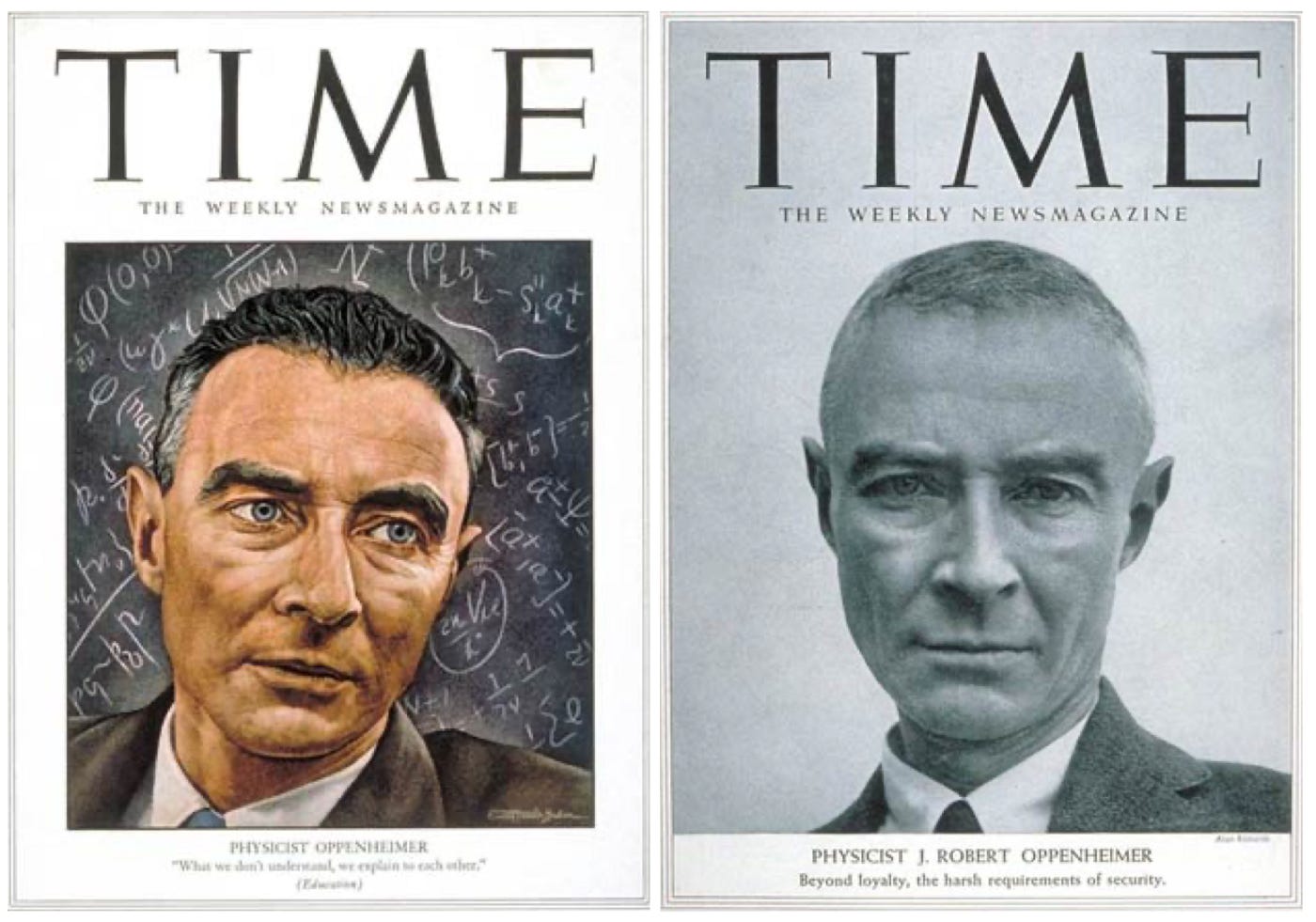
In 1946, Oppenheimer was awarded the Presidential Medal of Merit by Harry S. Truman. In 1963, President John F. Kennedy awarded Oppenheimer the Enrico Fermi Prize as a gesture towards his political rehabilitation following the FBI investigation. Teller, who had won the award the year before, had recommended Oppenheimer receive it in the hopes that it would help mend the rift between them following the former’s testimony. The award was presented by Kennedy’s successor President Lyndon B. Johnson for his “contributions to theoretical physics as a teacher and originator of ideas, and for leadership of the Los Alamos Laboratory and the atomic energy program during critical years”. Kennedy’s late wife Jacqueline made it a point to meet Oppenheimer after the ceremony, to tell him how important it was for her late husband that he receive the medal.
He was nominated for the Nobel Prize in Physics three times, in 1945, 1951 and 1967, but never won. Nobel Laureate Luis Alvarez later suggested that if Oppenheimer had lived long enough to see his predictions regarding gravitational collapse, concerning neutron stars and black holes to be shown empirically, he might have won. Regarding the importance of his work, Oppenheimer himself cited not his work on gravitational contraction, but rather his early work on electrons and positrons as the most important.

Oppenheimer remained at the Institute for Advanced Study until just before his death in 1967. His love of tobacco would lead to his development of throat cancer, diagnosed in late 1965. After an inconclusive surgery, unsuccessful radiation treatment and chemotherapy in 1966, he eventually fell into a coma and died in his home in Princeton on February the 18th, 1967. He was 62 years old. His memorial service was attended by over 600 people, a testament to his larger-than-life character.
Televised Interview
While still the Director of the Institute for Advanced Study, Oppenheimer appeared on the CBS television program See It Now hosted by Edward R. Murrow. The interview survives, and gives one the sense of Robert’s personality, passions and peculiarities in a way words simply cannot:

References
- Bethe, H. 1968. The Road from Los Alamos: Collected Essays of Hans A. Bethe. American Institute of Physics.
- Bird, K. & Sherwin, M. J. 2005. American Prometheus: The Triump and Tragedy of J. Robert Oppenheimer. Vintage Books.
- Kuhn, T. S. 1963. Interview with Oppenheimer. 18th of November, 1963. Cited in Pais (2006).
- Pais, A. 2006. J. Robert Oppenheimer: A Life*. Oxford University Press.
- Rabi, I. 1969. Oppenheimer. Scribner’s. New York, NY.
- Serber, R. & Crease, R. P. 1998. Peace and War: Reminiscences of a Life on the Frontiers of Science. New York: Columbia University Press.
- Thorpe, C. 2006. Oppenheimer: The Tragic Intellect. The University of Chicago Press, Chicago.
* This essay contains Amazon Affiliate Links

